Welcome to the fascinating universe of Animals that starts with N! If you’re intrigued by the fascinating creatures that live on our planet, then you’re going to be in for a treat. We’re about to embark on an adventure where we’ll get to meet 40 amazing creatures, each with their unique charms and quirks beginning with the letters “N.” Starting from the smallest creatures to the most powerful beasts, we’ll travel through forests, oceans deserts, grasslands, and deserts and discover the uniqueness of each animal.
So, prepare to get into the thrilling tales of these animals – some adorable, some somewhat creepy, but all incredible. We will discover amazing facts, fascinating scientific names, as well as the amazing places where these creatures are based.
1. Naked Mole Rat
| Kingdom | Scientific Name | Life Expectancy | Location |
| Animalia | Heterocephalus glaber | Up to 32 years | East Africa |
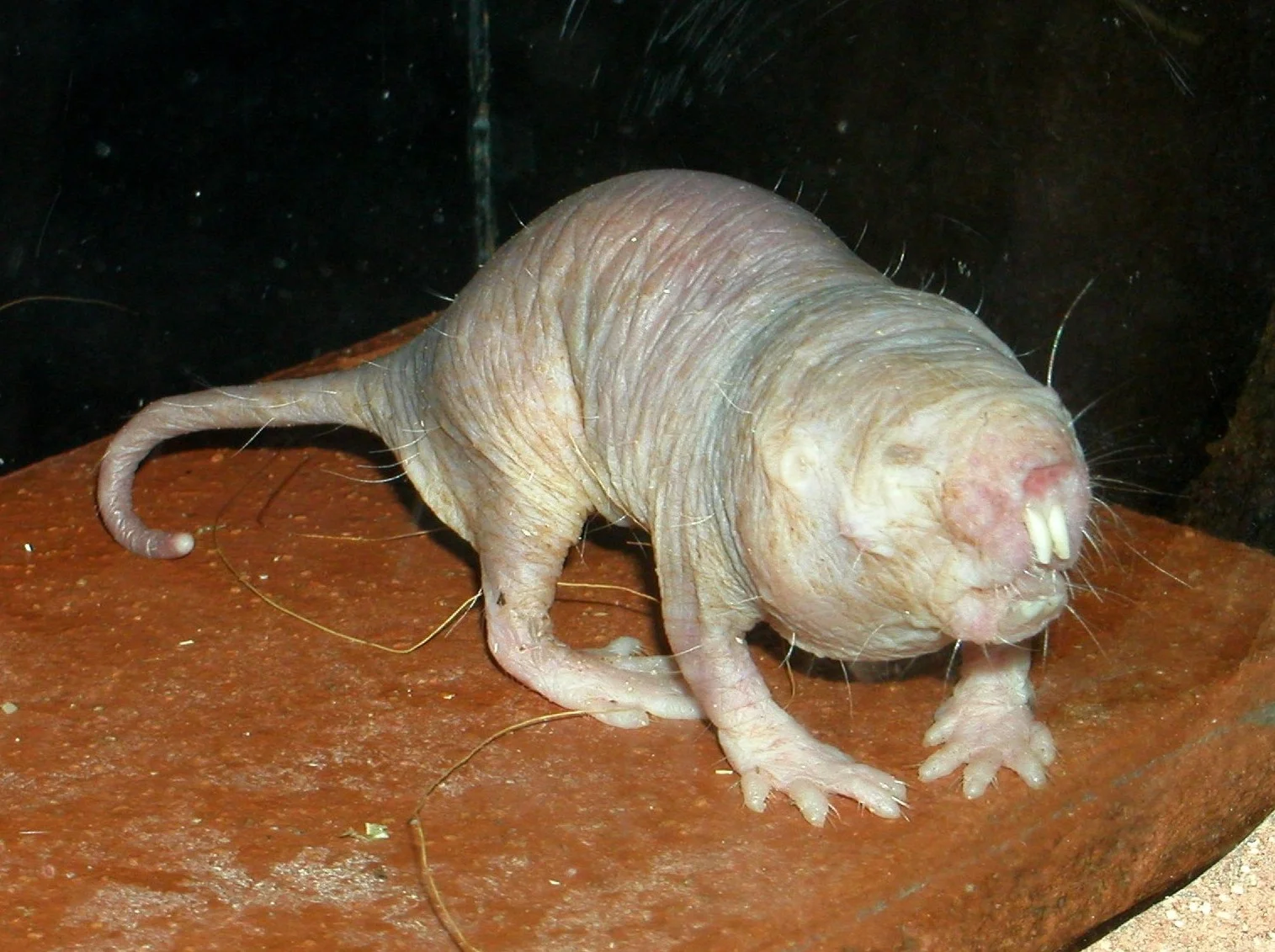 Discover East Africa’s hidden hero – the Naked Mole Rat! Imagine an adorable, hairless creature that resembles a miniature walrus with eyes in miniature form. These incredible underground dwellers not only look amazing; they are architects of intricate tunnel systems and vibrant societies similar to bee colonies – complete with queens, diligent workers, and fearless soldiers all living under one roof! What makes these fascinating little fellows even more fascinating is their longevity – some can live up to 30 years, outliving most rodents! Plus, Naked Mole Rats possess another secret weapon: cancer immunity! Offering scientists clues that could one day benefit humans too.
Discover East Africa’s hidden hero – the Naked Mole Rat! Imagine an adorable, hairless creature that resembles a miniature walrus with eyes in miniature form. These incredible underground dwellers not only look amazing; they are architects of intricate tunnel systems and vibrant societies similar to bee colonies – complete with queens, diligent workers, and fearless soldiers all living under one roof! What makes these fascinating little fellows even more fascinating is their longevity – some can live up to 30 years, outliving most rodents! Plus, Naked Mole Rats possess another secret weapon: cancer immunity! Offering scientists clues that could one day benefit humans too.
Fun Fact – These eccentric creatures may appear warm-blooded at first glance; however, unlike most mammals, they depend on external conditions for warmth instead. This unique trait adds another layer to their already fascinating profile, making them truly standout animals within the animal kingdom.
2. Narwhal
| Kingdom | Scientific Name | Life Expectancy | Location |
| Animalia | Monodon monoceros | Up to 50 years | Arctic waters |
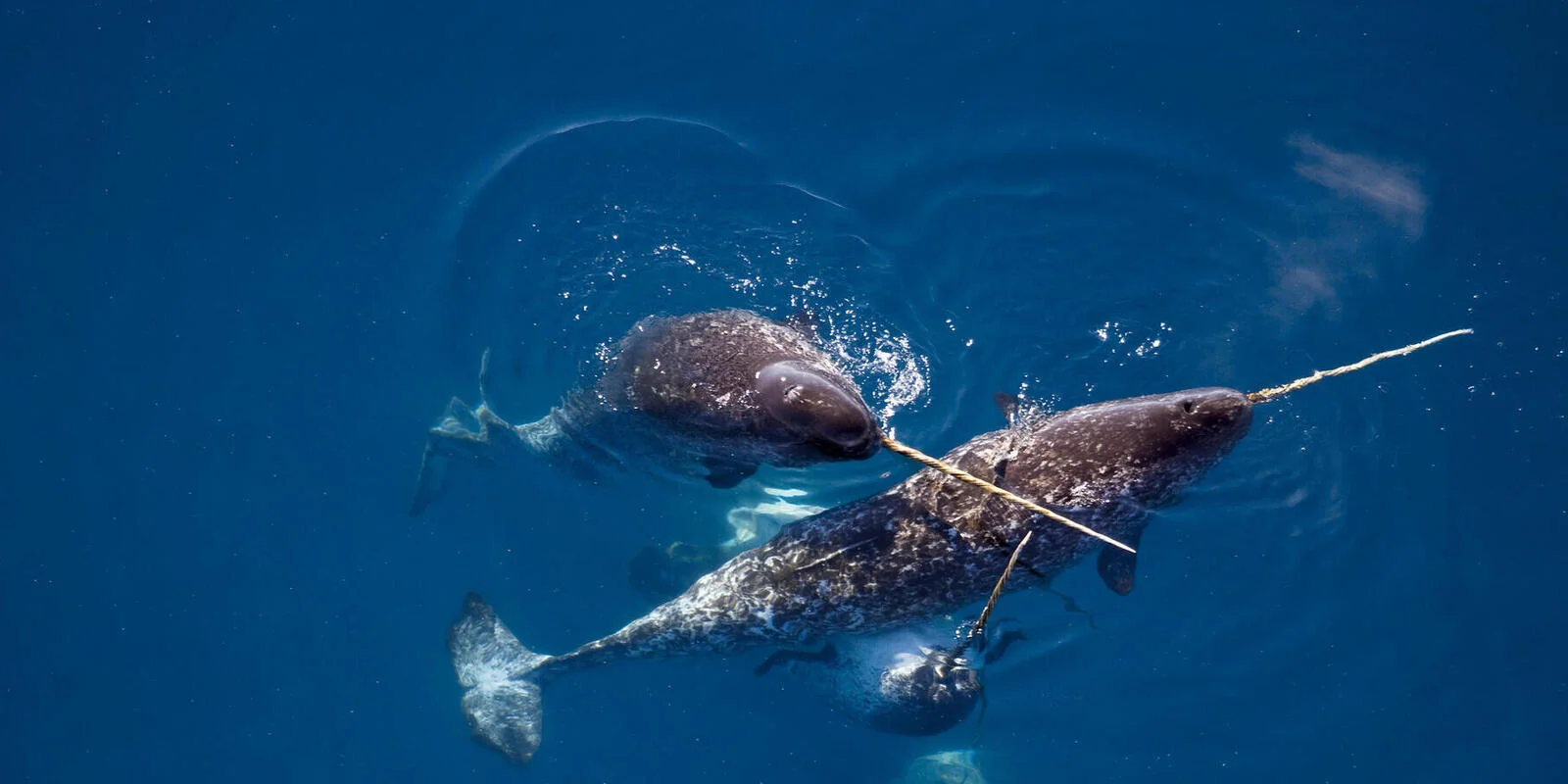 The Narwhal (Monodon monoceros) is an intriguing Arctic sea creature found near Canada, Greenland, Russia, and Norway. Popularly dubbed as the “unicorn of the sea”, its unique spiral tusk (essentially an elongated tooth that sometimes measures 10 feet long) has long been the subject of debate; early theories suggested hunting while more recent research points towards sensory perception and communication being its primary uses.
The Narwhal (Monodon monoceros) is an intriguing Arctic sea creature found near Canada, Greenland, Russia, and Norway. Popularly dubbed as the “unicorn of the sea”, its unique spiral tusk (essentially an elongated tooth that sometimes measures 10 feet long) has long been the subject of debate; early theories suggested hunting while more recent research points towards sensory perception and communication being its primary uses.
Narwhals live off a diet of fish and squid, relying on their remarkable diving capabilities to reach deep waters in search of food. Boasting unique mottled patterns that change over time, Narwhals provide insight into life in the harsh Arctic environment; their unassuming yet remarkable lives add further fascination to their Arctic environments.
Fun Fact – Narwhals have long been associated with myths and legends, as their spiral tusk has long been misconstrued as being part of the legendary unicorn’s horn – even being sold as such during medieval times! This misconception added mystique and mysticism to them and cemented their reputation as “unicorns of the sea”.
3. New Guinea Singing Dog
| Kingdom | Scientific Name | Life Expectancy | Location |
| Animalia | Canis dingo hallstromi | Up to 15 years | New Guinea |
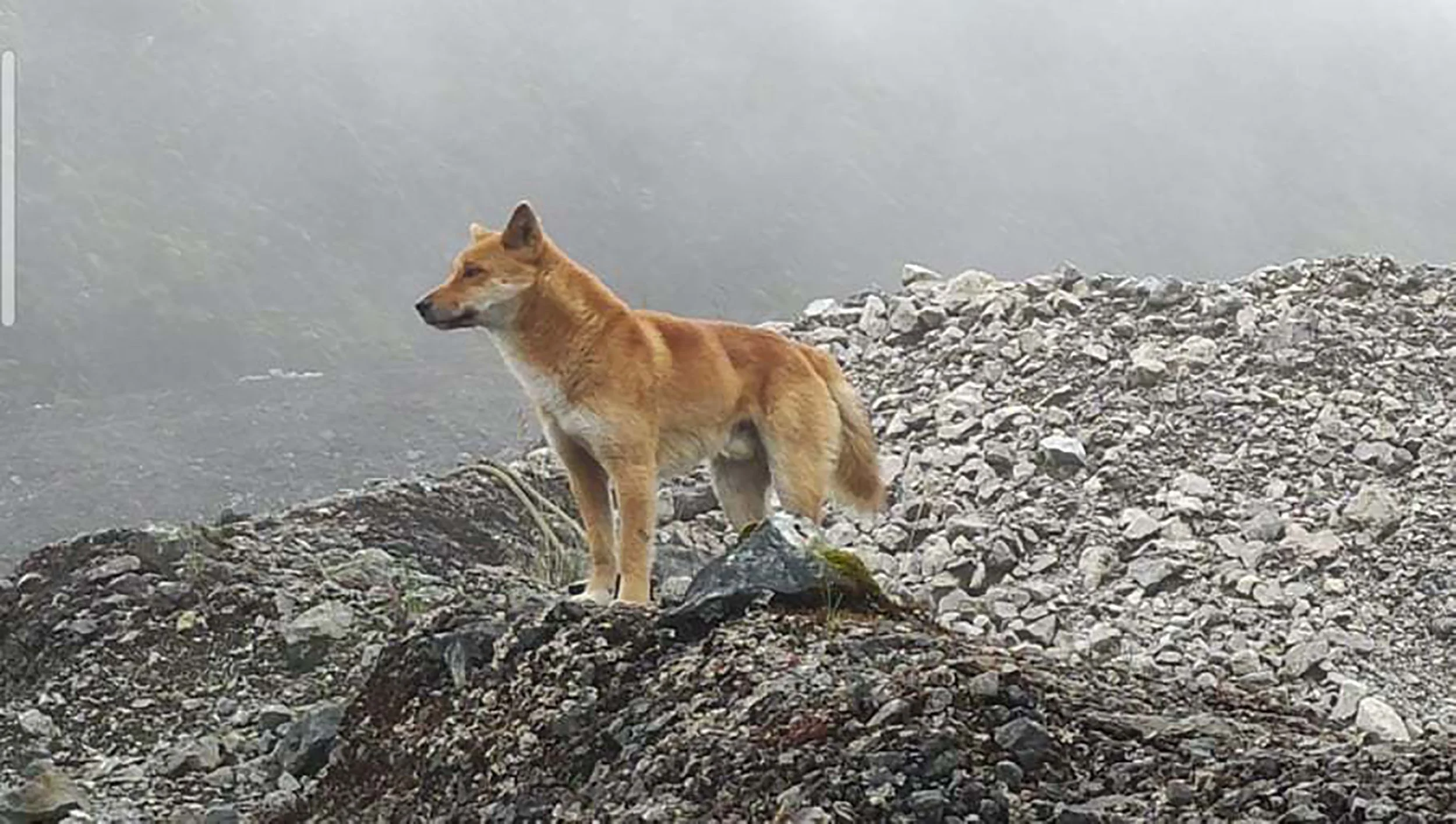 The New Guinea Singing Dog (Canis dingo hallstromi) is an exotic canine breed native to Papua New Guinea’s highlands, famed for its signature vocalizations resembling melodic howling or singing, earning it its unique moniker. This amazing communication method involves harmonic serenades as well as yodel-like calls, giving rise to its moniker of “singing dog”. Though domesticated, the New Guinea Singing Dog displays behaviors more characteristic of wild canines.
The New Guinea Singing Dog (Canis dingo hallstromi) is an exotic canine breed native to Papua New Guinea’s highlands, famed for its signature vocalizations resembling melodic howling or singing, earning it its unique moniker. This amazing communication method involves harmonic serenades as well as yodel-like calls, giving rise to its moniker of “singing dog”. Though domesticated, the New Guinea Singing Dog displays behaviors more characteristic of wild canines.
Their hunting instinct and agility rival that of their wild counterparts. Living in mountainous terrains, these dogs have adapted well to their environments with thick coats and sturdy builds to thrive there.
As they are rare and elusive, New Guinea Singing Dogs pose an ongoing conservation concern. Examining them reveals insight into human-canine coevolution as well as adaptations within their canine family.
Fun Fact – These dogs are considered to be one of the healthiest dog breeds in the world/.
4. Newt
| Kingdom | Scientific Name | Life Expectancy | Location |
| Animalia | Triturus vulgaris | Up to 15 years | North America |
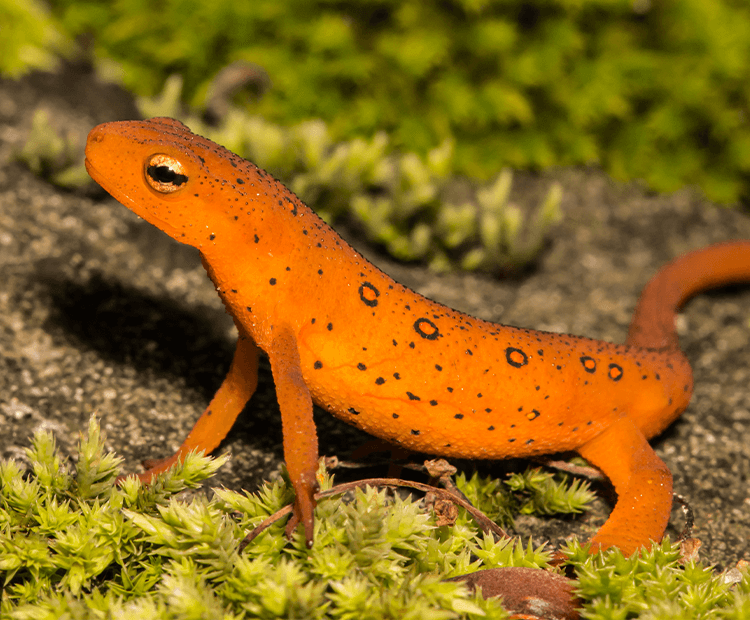 The Newt, an amphibian from the Salamandridae family, exhibits an astonishing life cycle. Beginning as an aquatic larva equipped with gills, this aquatic creature undergoes a remarkable metamorphosis into an aquatic juvenile terrestrial stage known as an Eft before going through another change to become an adult and return to an aquatic or semiaquatic environment for reproduction. One of the fascinating characteristics of newts is their variety, with different species boasting colorful designs and patterns. However, all species produce potency toxins as a defense mechanism against predators – highlighting their ecological importance.
The Newt, an amphibian from the Salamandridae family, exhibits an astonishing life cycle. Beginning as an aquatic larva equipped with gills, this aquatic creature undergoes a remarkable metamorphosis into an aquatic juvenile terrestrial stage known as an Eft before going through another change to become an adult and return to an aquatic or semiaquatic environment for reproduction. One of the fascinating characteristics of newts is their variety, with different species boasting colorful designs and patterns. However, all species produce potency toxins as a defense mechanism against predators – highlighting their ecological importance.
Fun Fact – Certain species of newts possess an amazing ability to regrow lost body parts. Should one become missing, such as an arm, leg, heart chamber, or brain region, its cells can grow back.
5. Nighthawk
| Kingdom | Scientific Name | Life Expectancy | Location |
| Animalia | Chordeiles minor | Up to 4 years | North and South America |
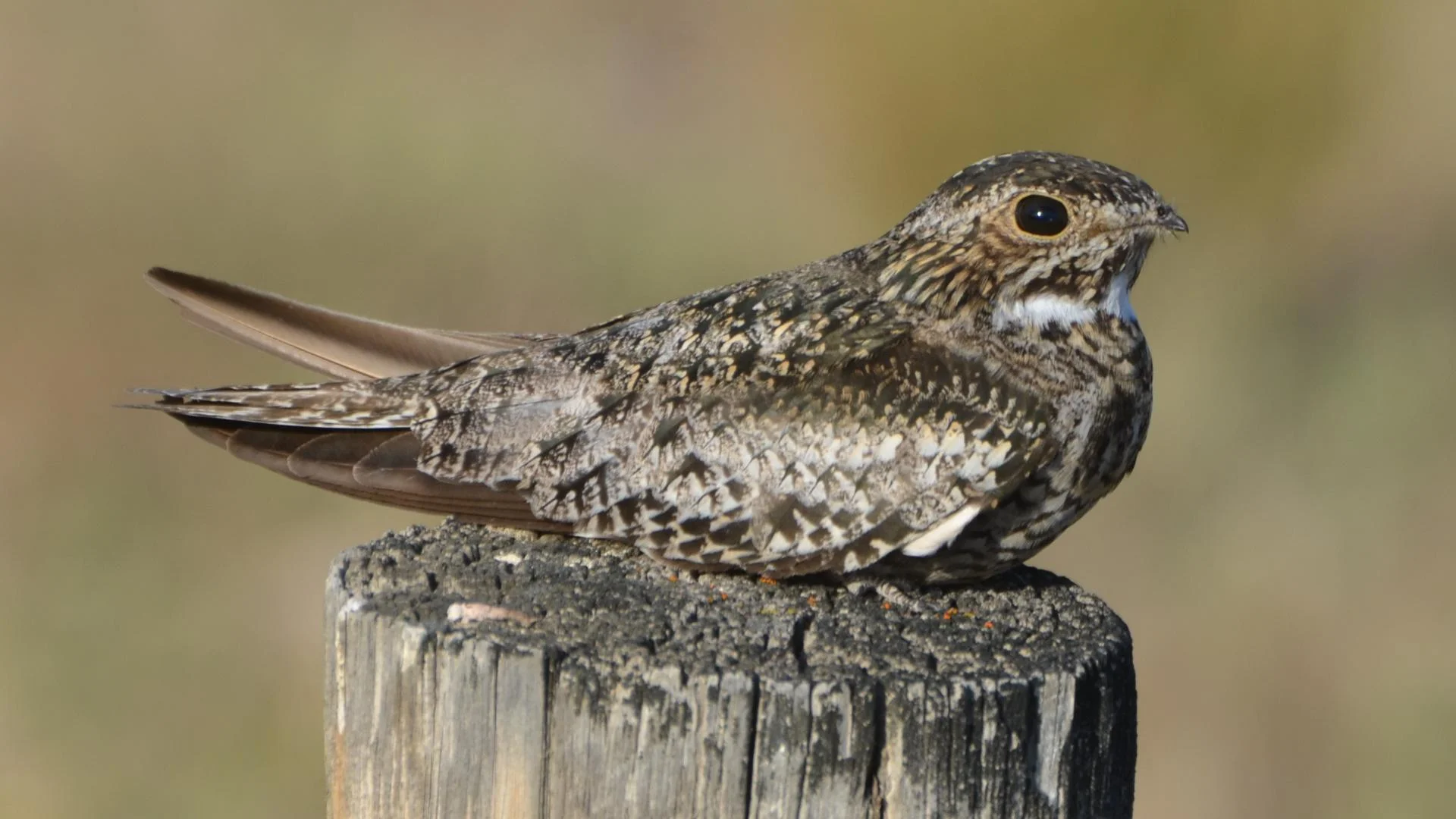 The Common Nighthawk (Chordeiles minor) is like that mysterious neighbor who you rarely catch glimpses of but know is up to something fascinating. This medium-sized bird, belonging to the Nightjar family, is found across the Americas. Recognizable by its mottled gray-brown plumage that camouflages seamlessly with its surroundings, the Nighthawk exhibits a distinctive silhouette with long, pointed wings and a slender body. Unlike typical birds, Nighthawks possess large, well-adapted eyes for low-light visibility, emphasizing their crepuscular nature.
The Common Nighthawk (Chordeiles minor) is like that mysterious neighbor who you rarely catch glimpses of but know is up to something fascinating. This medium-sized bird, belonging to the Nightjar family, is found across the Americas. Recognizable by its mottled gray-brown plumage that camouflages seamlessly with its surroundings, the Nighthawk exhibits a distinctive silhouette with long, pointed wings and a slender body. Unlike typical birds, Nighthawks possess large, well-adapted eyes for low-light visibility, emphasizing their crepuscular nature.
During mating displays, male Nighthawks engage in “booming” dives, creating a unique booming sound by pulling air through their wing feathers. Their diet primarily consists of flying insects, and they are often seen hunting on the wing, showcasing their agile and swift flight capabilities. The Nighthawk’s enigmatic presence and nocturnal habits make it a captivating species, embodying the allure of creatures thriving under the cover of darkness.
Fun Fact – The Common Nighthawk has a peculiar nesting habit – it often lays its eggs directly on bare ground, relying on its cryptic coloration to blend with the surroundings rather than constructing a traditional nest.
6. Nightingale
| Kingdom | Scientific Name | Life Expectancy | Location |
| Animalia | Luscinia megarhynchos | Up to 10 years | Europe, Asia, Africa |
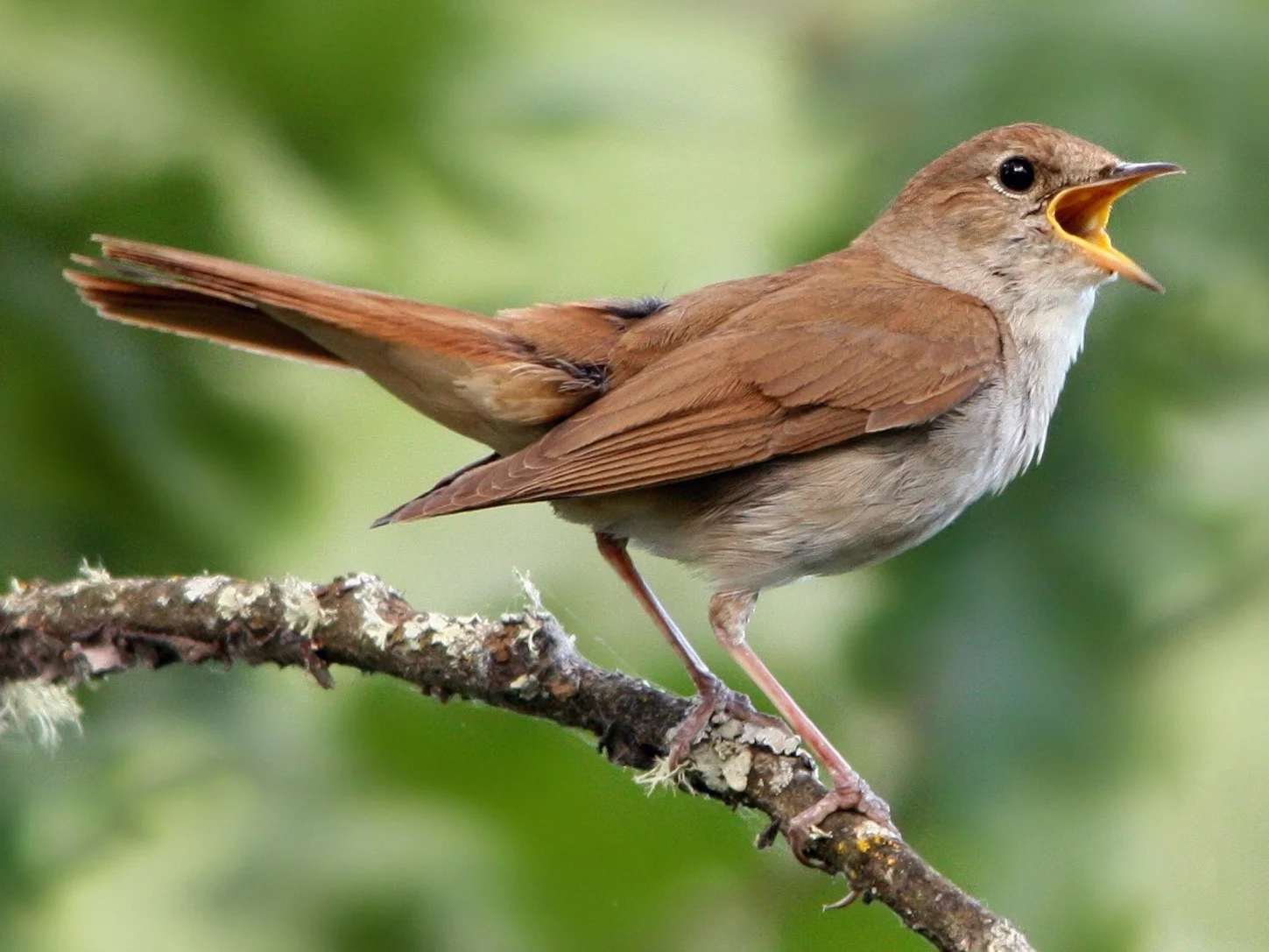 Meet the Nightingale (Luscinia megarhynchos), a modestly colored bird that compensates for its unassuming appearance with a truly enchanting song. Cloaked in earthy tones, this feathered artist captivates day and night, crooning melodies that have inspired poets through the ages. Yet, there’s more to these songsters than their musical virtuosity.
Meet the Nightingale (Luscinia megarhynchos), a modestly colored bird that compensates for its unassuming appearance with a truly enchanting song. Cloaked in earthy tones, this feathered artist captivates day and night, crooning melodies that have inspired poets through the ages. Yet, there’s more to these songsters than their musical virtuosity.
In the daily rhythm of life, Nightingales reveal another skill – they’re adept insect hunters. Crafting nests with precision just above the ground, tucked safely within bushes, these birds showcase not only an artistic flair but also a practical, nature-inspired approach to life.
Fun Fact – Nightingales are known for their unique ability to sing both day and night, earning them the name “night singer.”
7. Needlefish
| Kingdom | Scientific Name | Life Expectancy | Location |
| Animalia | Platybelone argalus | Up to 6 years | Global in tropical and subtropical waters |
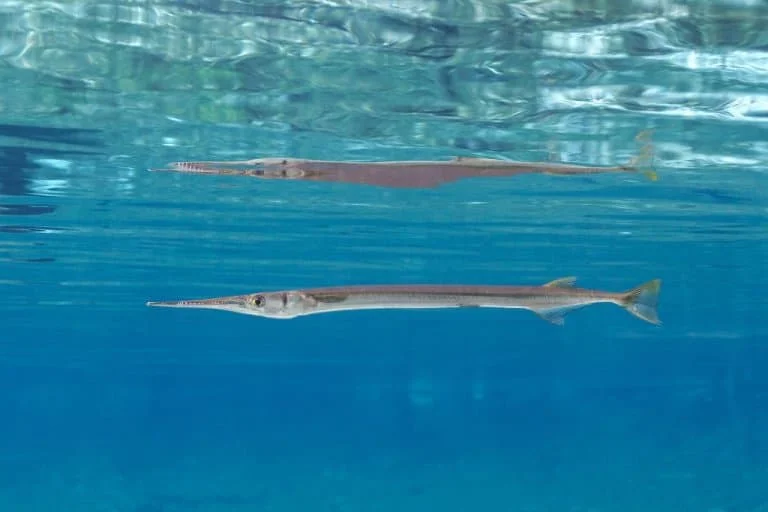 Needlefish (Platybelone argalus), members of the Belonidae family, are a fascinating group of slender, predatory fishes known for their distinctive appearance and behavior. These elongated fishes have a sleek, needle-like beak filled with sharp teeth, giving them a rather intimidating look. Some species of needlefish can grow up to four feet in length, making them a notable presence in coastal waters. What adds to their intrigue is their tendency to leap above the water’s surface, a behavior often observed around artificial light sources at night. This behavior, although seemingly erratic, is believed to be a method of navigating quickly, especially in pursuit of prey. Despite their formidable appearance, needlefish are not inherently aggressive toward humans, though their sharp beaks can pose a threat during leaps.
Needlefish (Platybelone argalus), members of the Belonidae family, are a fascinating group of slender, predatory fishes known for their distinctive appearance and behavior. These elongated fishes have a sleek, needle-like beak filled with sharp teeth, giving them a rather intimidating look. Some species of needlefish can grow up to four feet in length, making them a notable presence in coastal waters. What adds to their intrigue is their tendency to leap above the water’s surface, a behavior often observed around artificial light sources at night. This behavior, although seemingly erratic, is believed to be a method of navigating quickly, especially in pursuit of prey. Despite their formidable appearance, needlefish are not inherently aggressive toward humans, though their sharp beaks can pose a threat during leaps.
Fun Fact – Needlefish, with their needle-like jaws filled with sharp teeth, are high-speed predators, darting through the water to snatch small fish and insects near the surface.
8. Nabarlek
| Kingdom | Scientific Name | Life Expectancy | Location |
| Animalia | Petrogale concinna | Up to 5 years | Northern Australia |
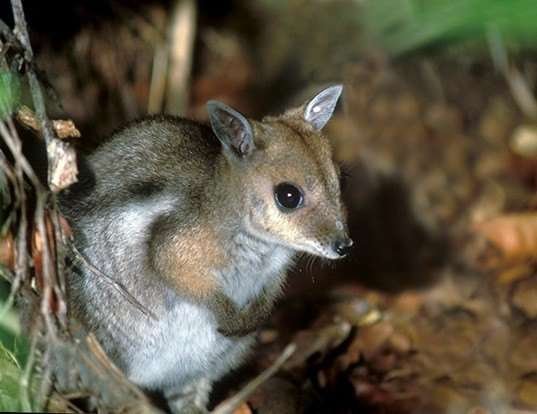 The Nabarlek (Petrogale concinna), commonly known as the Little Rock Wallaby, is an extraordinary marsupial exclusive to the rugged landscapes of the extreme northwest corner of Australia. Standing at less than a foot tall and weighing under 3 pounds, this diminutive wallaby is a master of adaptation.
The Nabarlek (Petrogale concinna), commonly known as the Little Rock Wallaby, is an extraordinary marsupial exclusive to the rugged landscapes of the extreme northwest corner of Australia. Standing at less than a foot tall and weighing under 3 pounds, this diminutive wallaby is a master of adaptation.
It strategically conceals itself in rocky terrain, emerging only at night to feed on grasses. What sets the Nabarlek apart is its unique dental feature—it’s the sole marsupial capable of growing an unlimited number of molars continuously. This dental adaptation helps it thrive on abrasive grasses. Despite its remarkable abilities, the Nabarlek is facing conservation challenges and is currently classified as an endangered species by the International Union for Conservation of Nature (IUCN).
Fun Fact – Despite its small size, the Nabarlek plays a crucial role in its ecosystem. As a herbivore, it helps control vegetation growth, contributing to the balance of plant life in the extreme northwest corner of Australia where it resides.
9. Nandu
| Kingdom | Scientific Name | Life Expectancy | Location |
| Animalia | Rhea pennata pennata | Up to 15 years | South America |
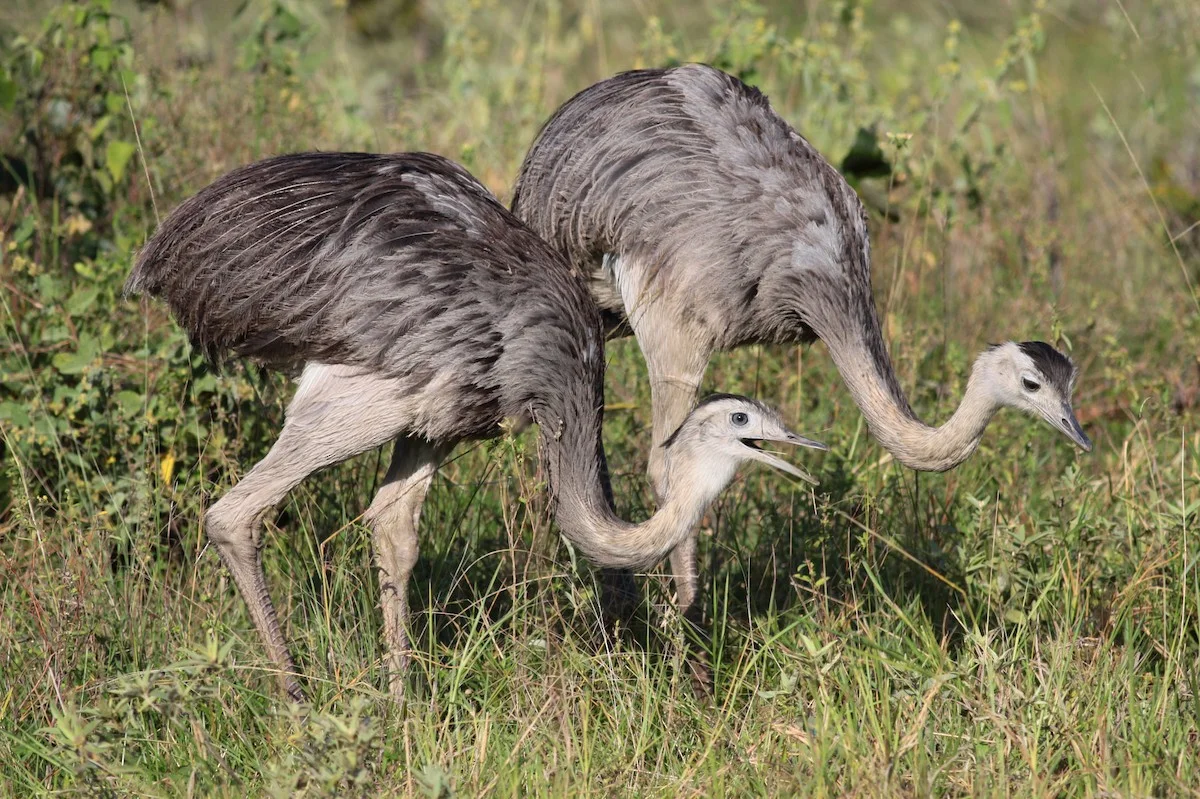 The Nandu, scientifically classified as Rhea americana, commands attention as a magnificent, flightless bird native to the vast landscapes of South America. This avian giant, often referred to as the Greater Rhea, stands proudly as one of the largest bird species globally, rivaling the height of an average person. Unlike its airborne counterparts, the Nandu showcases a unique blend of elegance and adaptability, gracefully navigating the expansive grasslands and open terrains of its native habitat.
The Nandu, scientifically classified as Rhea americana, commands attention as a magnificent, flightless bird native to the vast landscapes of South America. This avian giant, often referred to as the Greater Rhea, stands proudly as one of the largest bird species globally, rivaling the height of an average person. Unlike its airborne counterparts, the Nandu showcases a unique blend of elegance and adaptability, gracefully navigating the expansive grasslands and open terrains of its native habitat.
Cloaked in a shaggy coat and characterized by a statuesque neck and long legs, this herbivorous creature adds a touch of grandeur to the South American plains. Beyond its physical prowess, the Nandu embodies a cultural emblem, symbolizing the spirit of the region and leaving a lasting impression on those fortunate enough to witness its majestic presence.
Fun Fact – The Greater Rhea, commonly known as Nandu, is a speedy sprinter, reaching up to 35 mph (56 km/h). This large, flightless bird’s surprising agility adds a delightful touch to the South American grasslands.
10. Nile Crocodile
| Kingdom | Scientific Name | Life Expectancy | Location |
| Animalia | Crocodylus niloticus | Up to 70 years | Sub-Saharan Africa |
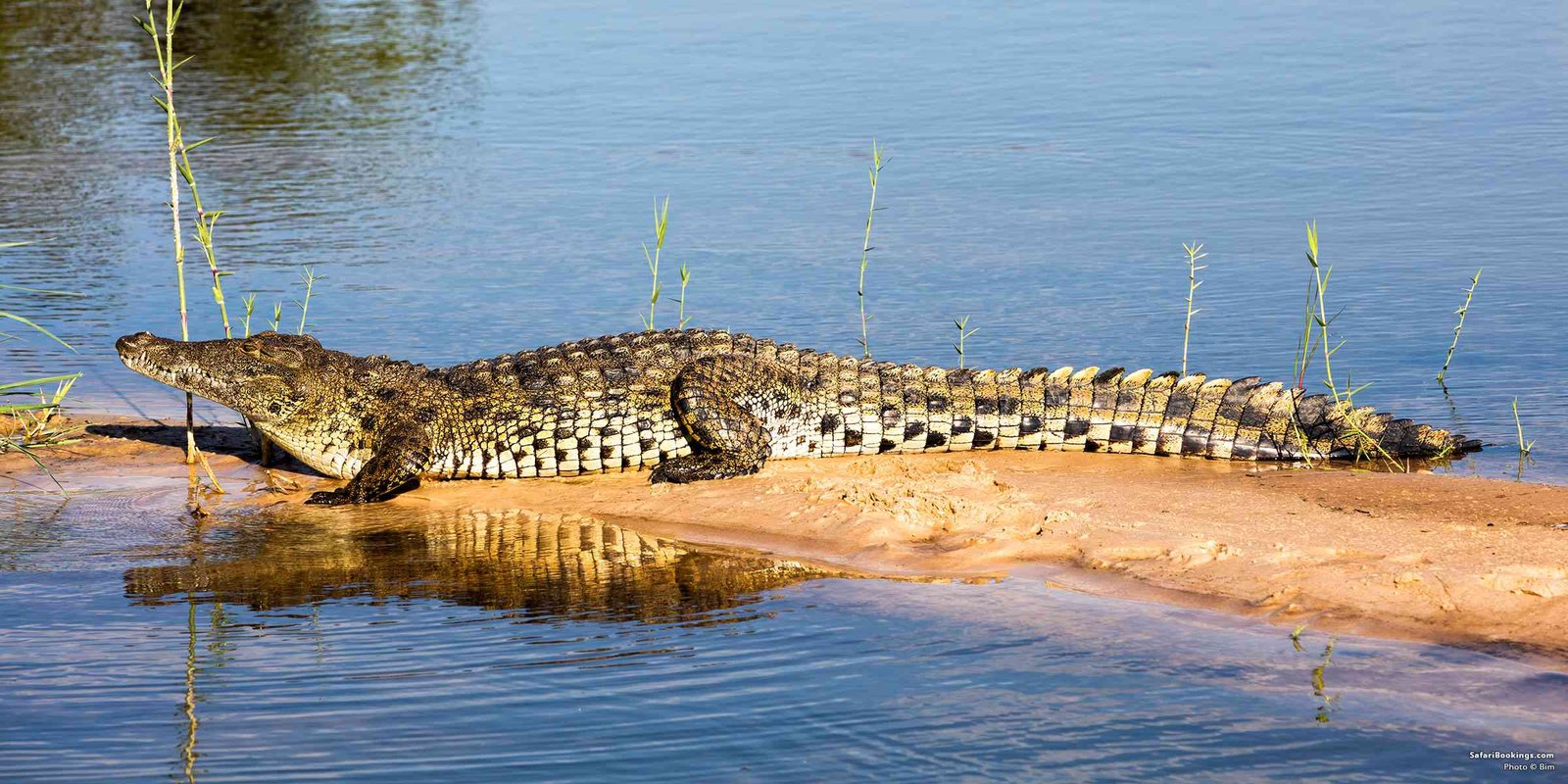 The Nile Crocodile (Crocodylus niloticus) is a prominent reptile found across various African landscapes, primarily inhabiting freshwater environments such as rivers, lakes, and marshes. Renowned for its adaptability, this species holds the title of Africa’s largest crocodilian and is characterized by its robust physique and aggressive nature. Exhibiting proficient swimming skills, Nile Crocodiles are adept predators, targeting a diverse range of prey including fish, birds, and mammals along the water’s edge.
The Nile Crocodile (Crocodylus niloticus) is a prominent reptile found across various African landscapes, primarily inhabiting freshwater environments such as rivers, lakes, and marshes. Renowned for its adaptability, this species holds the title of Africa’s largest crocodilian and is characterized by its robust physique and aggressive nature. Exhibiting proficient swimming skills, Nile Crocodiles are adept predators, targeting a diverse range of prey including fish, birds, and mammals along the water’s edge.
Their hunting strategies, marked by calculated ambushes and occasional group coordination, underscore their intelligence. Nile Crocodiles play a crucial role in maintaining the ecological balance of aquatic ecosystems, but their aggressive nature and proximity to human populations also make them a potential threat, leading to complex conservation challenges.
Fun Fact – Despite their fearsome reputation, Nile Crocodiles exhibit surprising parental care. Females construct nests with vegetation, fiercely protecting the eggs. They even carry hatchlings in their mouths to the water, showcasing a rare and nurturing side of these formidable reptiles.
11. Nightfish
| Kingdom | Scientific Name | Life Expectancy | Location |
| Animalia | Bostockia porosa | Up to 15 years | South America |
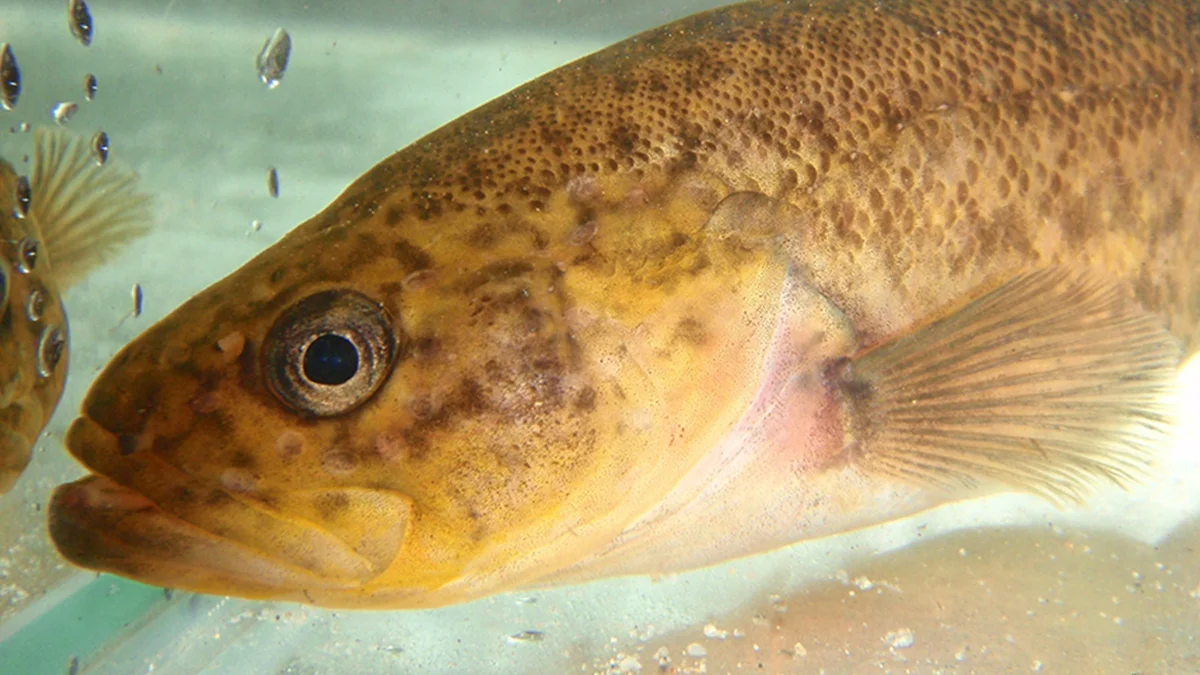 The Nightfish (Bostockia porosa) is a freshwater ambush predator native to coastal Southwestern Australia. Measuring around six inches in length, this creature belongs to the perch family and is known for its nocturnal habits. Typically growing to the size of an average human hand, the Nightfish navigates through freshwater streams, lakes, and ponds, preying on small fish, crayfish, and aquatic insects.
The Nightfish (Bostockia porosa) is a freshwater ambush predator native to coastal Southwestern Australia. Measuring around six inches in length, this creature belongs to the perch family and is known for its nocturnal habits. Typically growing to the size of an average human hand, the Nightfish navigates through freshwater streams, lakes, and ponds, preying on small fish, crayfish, and aquatic insects.
Its unassuming appearance contrasts with its adept hunting skills, relying on the cover of darkness to stealthily approach its prey. Despite its unremarkable size, the Nightfish plays a vital role in the aquatic ecosystem, contributing to the delicate balance of species in its habitat. The unique behavior of this unobtrusive predator serves as a testament to nature’s intricacies, where even seemingly ordinary creatures have a significant role in their ecosystem.
Fun Fact – The Nightfish (Bostockia porosa) is a master of disguise with its unique color-changing ability. It adapts to lighter hues during the day and transitions to darker shades at night, seamlessly blending into its coastal southwestern Australian habitat.
12. Nautilus
| Kingdom | Scientific Name | Life Expectancy | Location |
| Animalia | Nautilus | Up to 20 years | Deep ocean reefs |
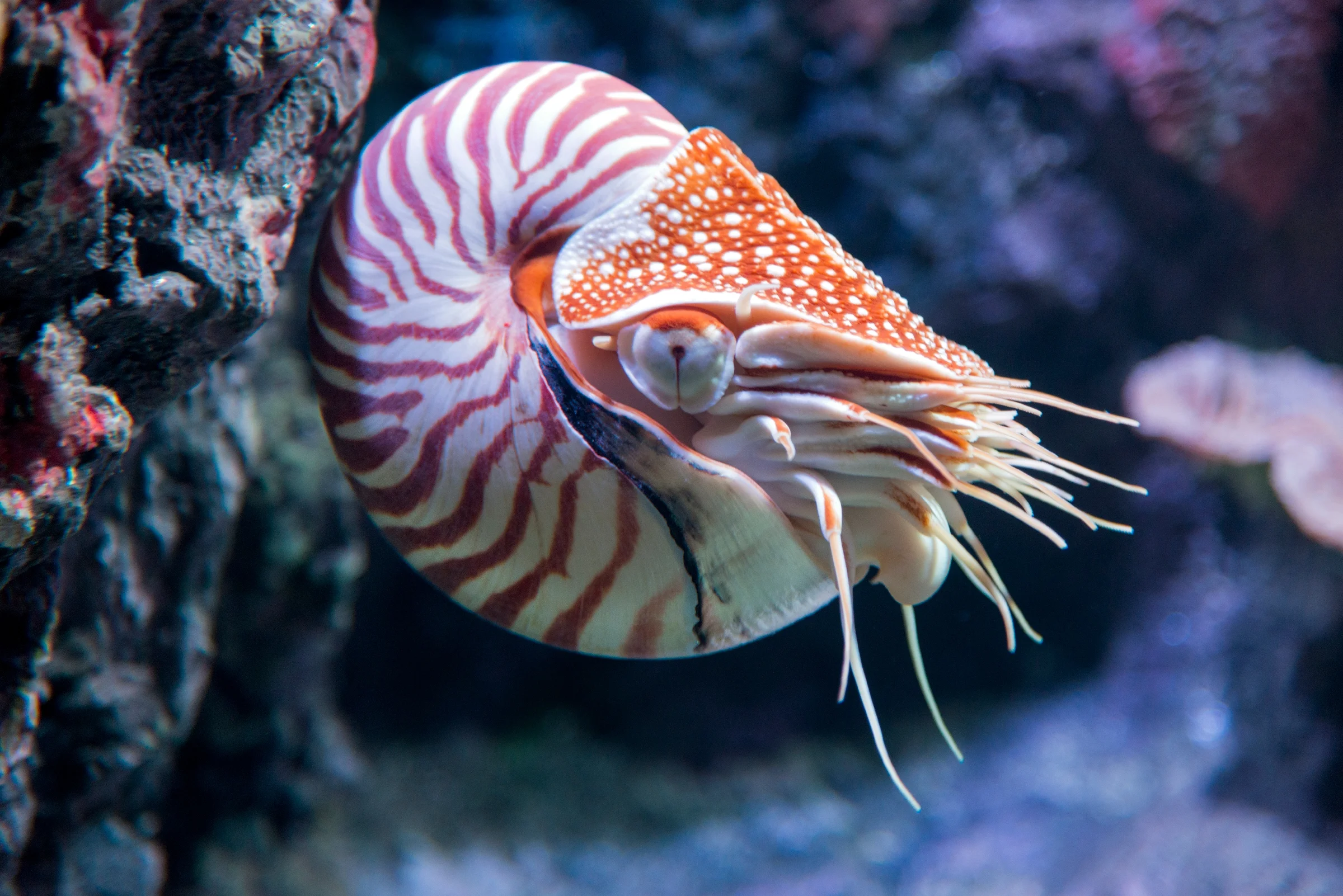 Meet the fascinating Nautilus, an ocean dweller, introduces us to the marvels of marine life with its intricate chambered shell and unique jet propulsion. Within this spiral-shaped shell resides a soft-bodied cephalopod, showcasing a design that has remained relatively unchanged for over 500 million years. These living fossils utilize jet propulsion, gracefully maneuvering through the ocean depths by expelling seawater through their chambers.
Meet the fascinating Nautilus, an ocean dweller, introduces us to the marvels of marine life with its intricate chambered shell and unique jet propulsion. Within this spiral-shaped shell resides a soft-bodied cephalopod, showcasing a design that has remained relatively unchanged for over 500 million years. These living fossils utilize jet propulsion, gracefully maneuvering through the ocean depths by expelling seawater through their chambers.
As extraordinary members of the Cephalopod family, which includes octopuses, squid, and cuttlefish, Nautiluses stand out with their enduring presence and ancient lineage. Their shells, filled with inert gas for buoyancy control, contribute to their graceful movements. Despite their prehistoric origins, Nautiluses continue to capture our imagination as they navigate the deep, embodying the elegance of ocean life.
Fun Fact – The Nautilus, a deep-sea marvel, resides in ocean reefs at depths of 50 to 600 meters. Its simple eyes detect only light and dark and equipped with up to 94 tentacles, it skillfully captures prey, showcasing the incredible adaptations that make it a unique and captivating cephalopod.
13. Nightjar
| Kingdom | Scientific Name | Life Expectancy | Location |
| Animalia | Caprimulgus europaeus | Up to 5 years | Europe, Asia, Africa |
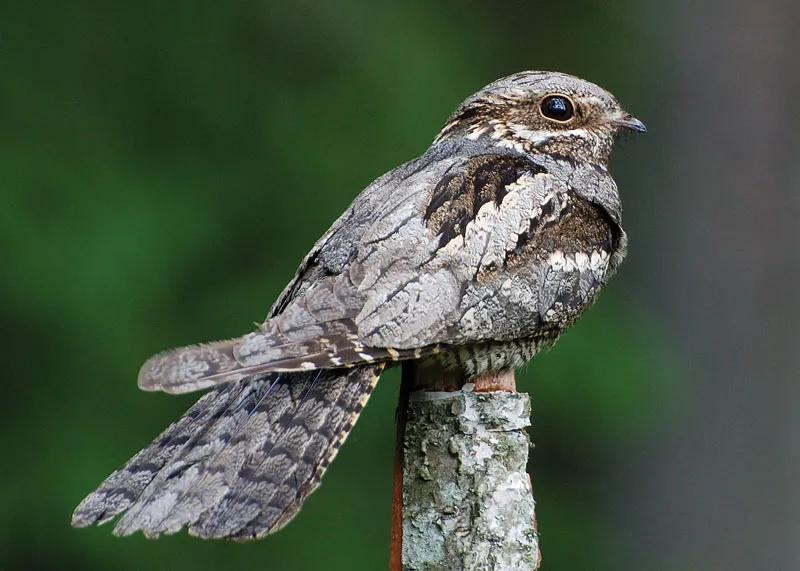 Nightjars, a mesmerizing group of nocturnal and crepuscular birds, enchant with their haunting calls and aerial displays. With around 100 species globally, they are masters of camouflage, perching to blend seamlessly with branches. The Eastern Whip-poor-will in North America is a notable member, filling the night with its distinctive call.
Nightjars, a mesmerizing group of nocturnal and crepuscular birds, enchant with their haunting calls and aerial displays. With around 100 species globally, they are masters of camouflage, perching to blend seamlessly with branches. The Eastern Whip-poor-will in North America is a notable member, filling the night with its distinctive call.
These birds, adapted to twilight activities, employ unique hunting techniques to capture insects during nocturnal flights. Whether witnessed in South African night drives or hearing the melodious tunes of American species, nightjars bring a touch of magic to the avian world.
Fun Fact – Nightjars are aerial masters, deftly capturing insects mid-flight with their wide mouths and specialized bristles, showcasing remarkable nocturnal hunting skills.
14. Ningaui
| Kingdom | Scientific Name | Life Expectancy | Location |
| Animalia | Ningaui yvonneae | Up to 2 years | Australia |
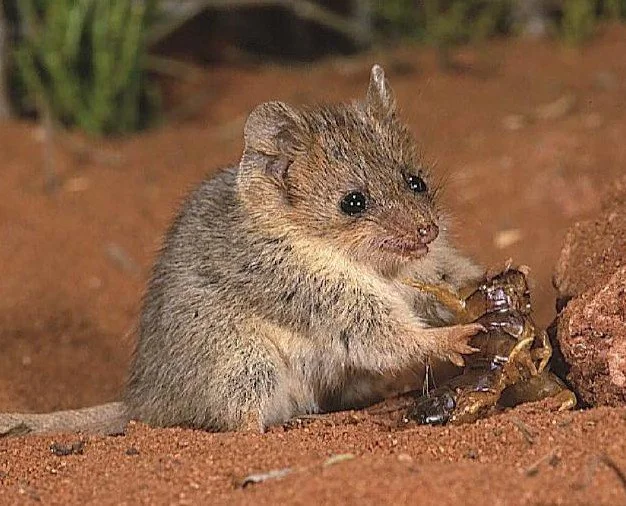 The Ningaui, a tiny carnivorous marsupial exclusive to Australia, captivates with its diminutive yet intriguing presence. Discovered as recently as 1975, these elusive creatures weigh less than 10 grams and resemble miniature rodents. Armed with sharp teeth, they are formidable insect hunters, showcasing their prowess in the intricate ecosystems of the Australian bush. Active primarily at night, Ningaui navigates its surroundings with agility, contributing to the rich biodiversity of the continent. Despite their small size, these marsupials play a crucial role in maintaining the delicate balance of Australia’s diverse fauna.
The Ningaui, a tiny carnivorous marsupial exclusive to Australia, captivates with its diminutive yet intriguing presence. Discovered as recently as 1975, these elusive creatures weigh less than 10 grams and resemble miniature rodents. Armed with sharp teeth, they are formidable insect hunters, showcasing their prowess in the intricate ecosystems of the Australian bush. Active primarily at night, Ningaui navigates its surroundings with agility, contributing to the rich biodiversity of the continent. Despite their small size, these marsupials play a crucial role in maintaining the delicate balance of Australia’s diverse fauna.
Fun Fact – Despite their size, Ningaui are fierce predators, possessing sharp teeth to efficiently hunt and consume insects, showcasing nature’s remarkable adaptations in the intricate web of Australia’s wildlife.
15. Noddy
| Kingdom | Scientific Name | Life Expectancy | Location |
| Animalia | Anous stolidus | Up to 25 years | Global in tropical and subtropical regions |
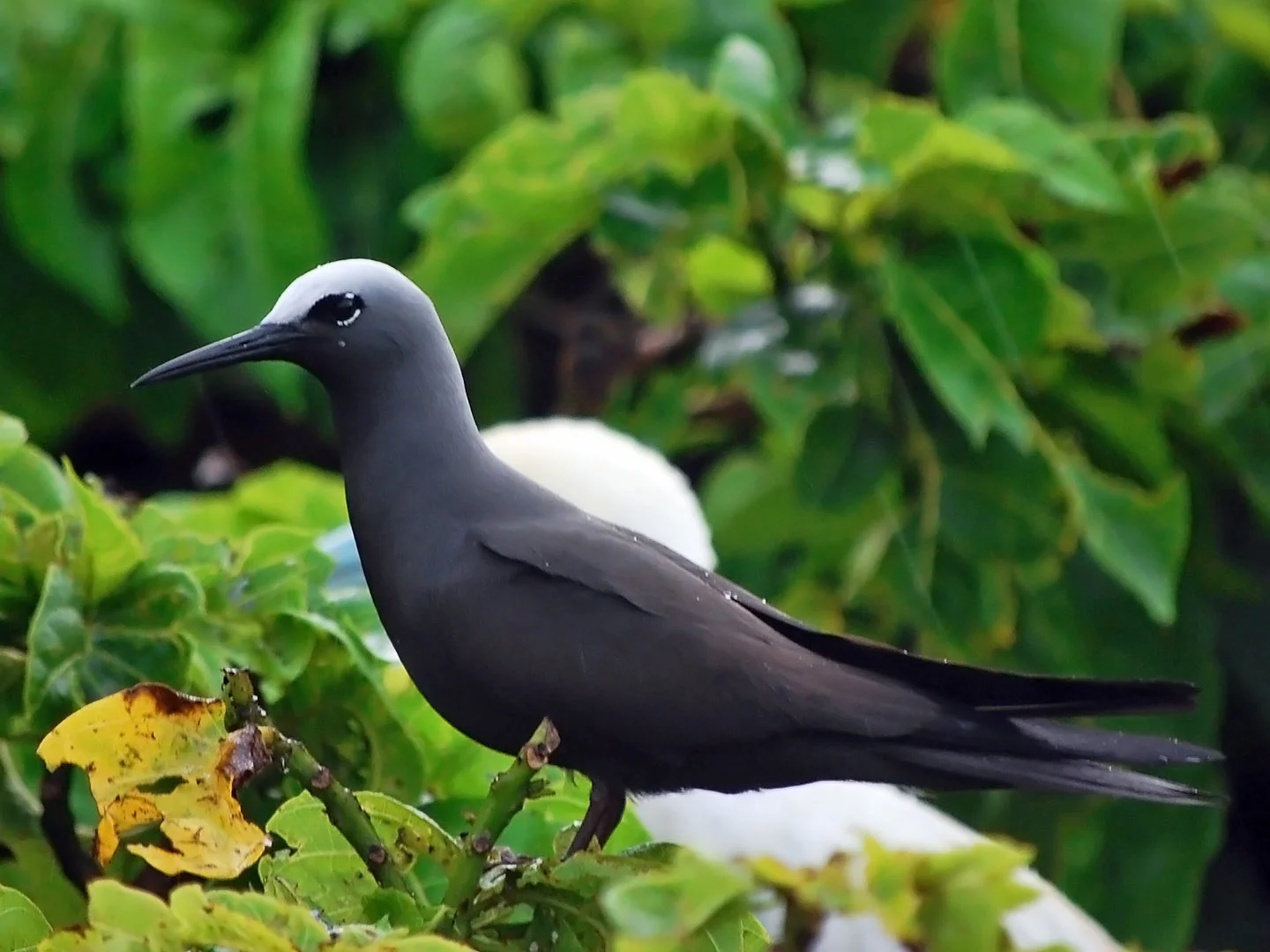 The noddy, a seabird belonging to the genus Anous, is a fascinating species found in tropical oceans worldwide. Known for its distinctive black plumage, the brown noddy, specifically, is a notable representative. These birds display remarkable aerial skills, catching fish by skillfully dipping their bills into the ocean’s surface.
The noddy, a seabird belonging to the genus Anous, is a fascinating species found in tropical oceans worldwide. Known for its distinctive black plumage, the brown noddy, specifically, is a notable representative. These birds display remarkable aerial skills, catching fish by skillfully dipping their bills into the ocean’s surface.
Brown noddies are social creatures, nesting in large and noisy colonies, creating a lively and bustling atmosphere on their breeding grounds. Their ability to cover vast oceanic distances during foraging and their engaging nesting behaviors contribute to the ecological richness of tropical marine environments where they play a crucial role in maintaining the balance of marine ecosystems.
Fun Fact – Brown noddies, like other members of the Anous genus, are known for their distinctive, slightly comical appearance. With their dark plumage and contrasting white caps, they resemble avian figures donning expressive, oversized sunglasses, adding a touch of whimsy to the birdwatcher’s experience.
16. Natterjack
| Kingdom | Scientific Name | Life Expectancy | Location |
| Animalia | Epidalea calamita | Up to 5 years | Europe, Asia |
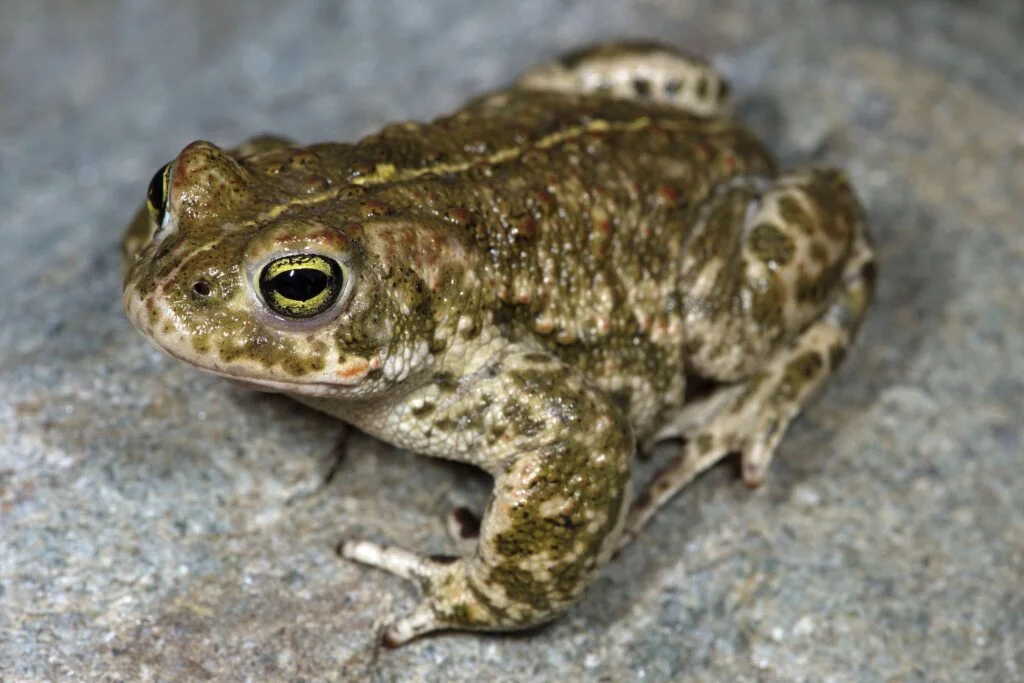 Natterjack Toad, scientifically known as Epidalea calamita, is a distinctive amphibian found across Western Europe, favoring sandy coastal dunes and heathlands. Recognizable by a prominent yellow stripe running along its back, the Natterjack Toad earned its name from the loud calls, often likened to “nattering,” produced during the mating season.
Natterjack Toad, scientifically known as Epidalea calamita, is a distinctive amphibian found across Western Europe, favoring sandy coastal dunes and heathlands. Recognizable by a prominent yellow stripe running along its back, the Natterjack Toad earned its name from the loud calls, often likened to “nattering,” produced during the mating season.
Adapted to a semi-aquatic lifestyle, these toads lay their eggs in temporary water bodies like ponds, relying on the ephemeral nature of such habitats. The Natterjack Toad’s conservation status is of concern due to the degradation of its preferred habitats, making conservation efforts crucial for preserving this charismatic amphibian and its vital role in maintaining ecological balance.
Fun Fact – The Natterjack Toad, renowned for its jumping skills, has a unique call that resembles a “running horse” or a “barking dog.” This distinctive vocalization plays a crucial role in their nocturnal mating rituals.
17. Noctule
| Kingdom | Scientific Name | Life Expectancy | Location |
| Animalia | Nyctalus noctula | Up to 9 years | Europe, Asia |
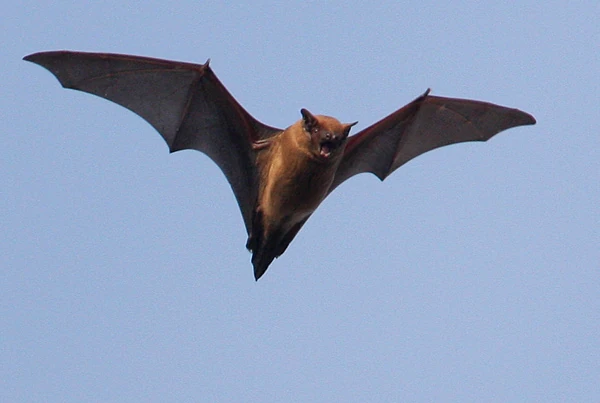 Meet the Noctule, a fascinating bat that’s a regular resident across Europe and parts of Asia. This mid-sized marvel, scientifically known as Nyctalus noctula, stands out for its robust build and intriguing habits. As the summer sunsets, the Noctule takes flight, skillfully hunting down large moths and beetles over lush forests and watery expanses.
Meet the Noctule, a fascinating bat that’s a regular resident across Europe and parts of Asia. This mid-sized marvel, scientifically known as Nyctalus noctula, stands out for its robust build and intriguing habits. As the summer sunsets, the Noctule takes flight, skillfully hunting down large moths and beetles over lush forests and watery expanses.
When winter chills the air, these bats opt for cozy spots like rock caves or even human-made structures to snuggle in for hibernation. Surprisingly, you might spot them in bustling Eastern European cities, proving their knack for city living. Cloaked in cryptic colors and leading a nightlife that’s both elusive and enchanting, the Noctule adds a touch of mystery to the world of bats.
Fun Fact – They hold the title of being the largest bat species in Europe, boasting an impressive wingspan that can reach up to 14 inches (35 cm).
18. Nunlet
| Kingdom | Scientific Name | Life Expectancy | Location |
| Animalia | Nonnula | Up to 5 years | Americas |
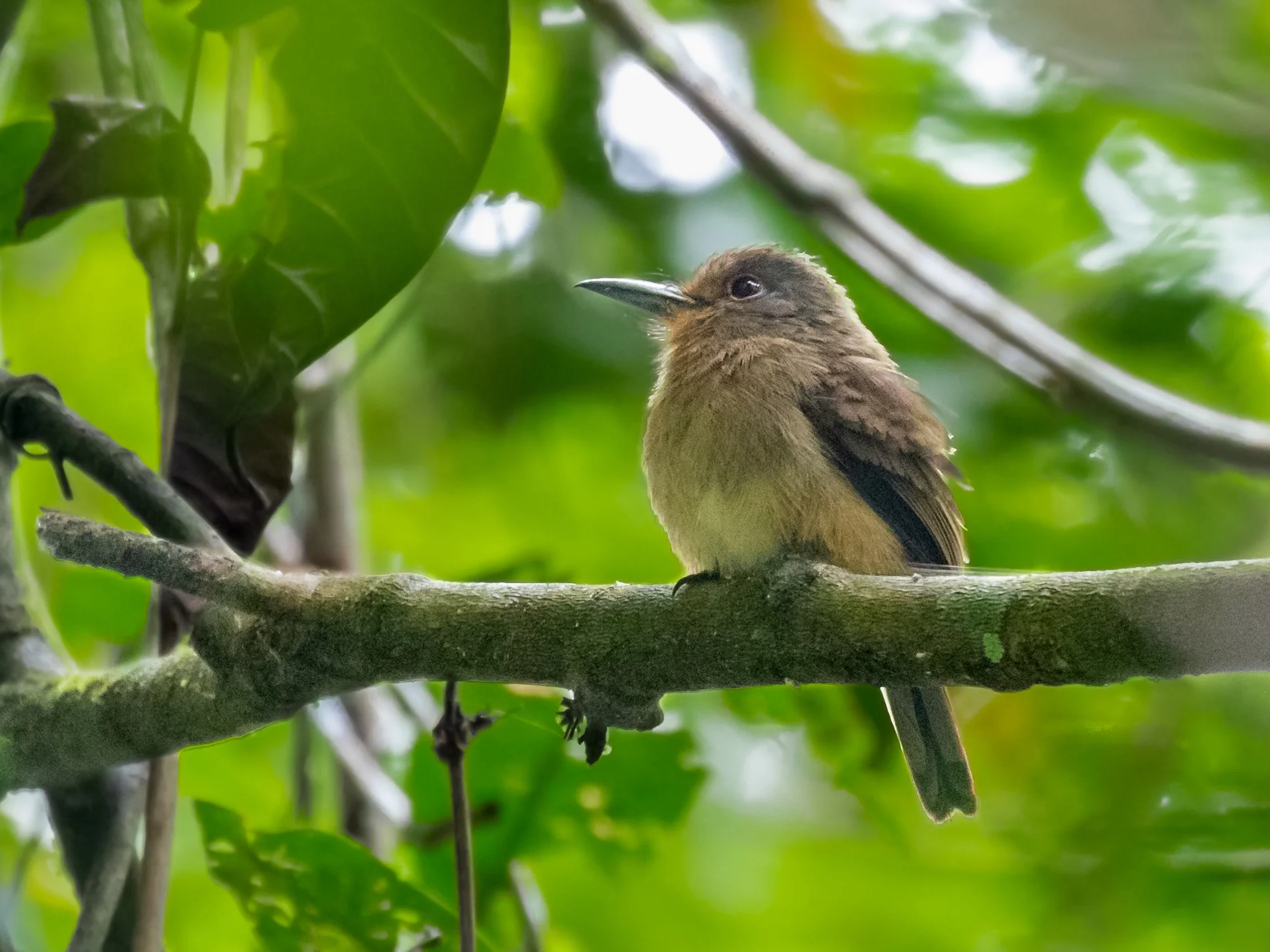 The Nunlet, a petite and charming bird, belongs to the puffbird family and is specifically found in the lush landscapes of Western Amazonia. Notably, there are six species of Nunlets, and the one illustrated here is the delightful Brown Nunlet. With its glossy dark feathers and a distinctive white area around the beak, resembling a nun’s habit, it adds a touch of whimsy to the avian realm.
The Nunlet, a petite and charming bird, belongs to the puffbird family and is specifically found in the lush landscapes of Western Amazonia. Notably, there are six species of Nunlets, and the one illustrated here is the delightful Brown Nunlet. With its glossy dark feathers and a distinctive white area around the beak, resembling a nun’s habit, it adds a touch of whimsy to the avian realm.
These avian creatures are master nest-builders, crafting spherical nests from spiderwebs and dry grasses, featuring a small circular entrance on the side—a charming resemblance to a tiny avian hobbit hole. Inhabitants of Central and South America, Nunlets bring a sense of grace and playfulness to their tropical habitats.
Fun Fact – The brown nunlet has brown upperparts, buffy underparts, and dark grayish brown cheeks. It also has a thin orange eye-ring and a large bill with long bristles at the base.
19. Nurseryfish
| Kingdom | Scientific Name | Life Expectancy | Location |
| Animalia | Kurtus gulliveri | Up to 5 years | Australia, New Guinea |
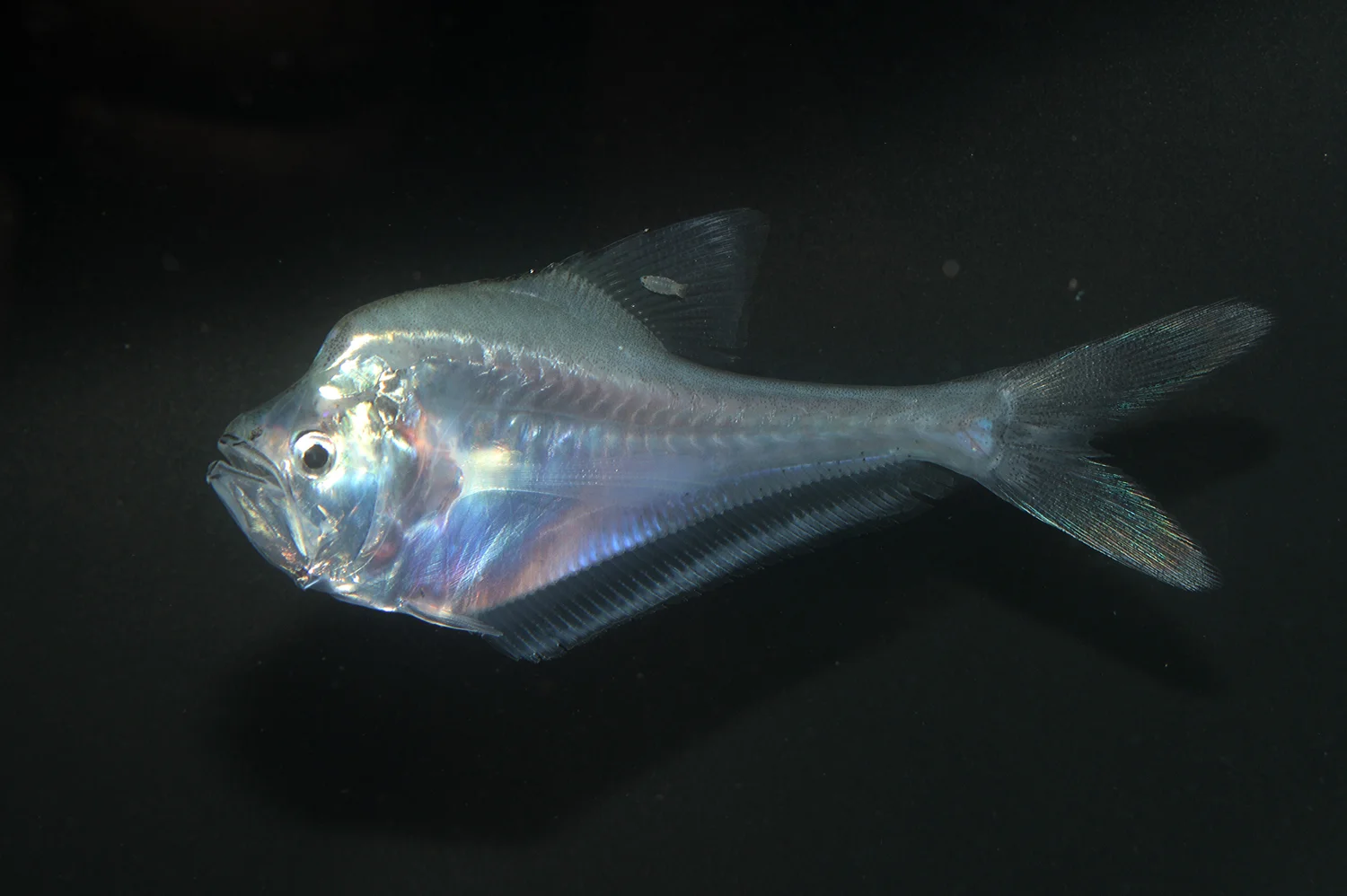 The nurseryfish (Kurtus gulliveri) stands out in the aquatic world with its distinctive reproductive strategy. In an intriguing twist, the male nurseryfish grows a peculiar hook on its forehead, which it utilizes as a carrying apparatus for a cluster of eggs. This method, known as forehead brooding, is a rare adaptation to the challenging conditions of the swamps and estuaries in Southern New Guinea and Northern Australia, where these fish inhabit.
The nurseryfish (Kurtus gulliveri) stands out in the aquatic world with its distinctive reproductive strategy. In an intriguing twist, the male nurseryfish grows a peculiar hook on its forehead, which it utilizes as a carrying apparatus for a cluster of eggs. This method, known as forehead brooding, is a rare adaptation to the challenging conditions of the swamps and estuaries in Southern New Guinea and Northern Australia, where these fish inhabit.
The females, in contrast, do not develop this forehead hook. Apart from their fascinating reproductive behavior, nurseryfish are also recognized for their elongated, slender bodies and nearly transparent, scaleless skin. Their presence in the freshwater ecosystems of Australasia adds a layer of uniqueness to the diverse array of aquatic life in the region.
Fun Fact – Nurseryfish are known for their remarkable ability to carry and protect their eggs using a specialized hook on their foreheads. This distinctive adaptation sets them apart in the underwater realm, showcasing the diverse and ingenious strategies that aquatic species employ for reproduction and survival.
20. Nilgai
| Kingdom | Scientific Name | Life Expectancy | Location |
| Animalia | Boselaphus tragocamelus | Up to 21 years | Indian subcontinent |
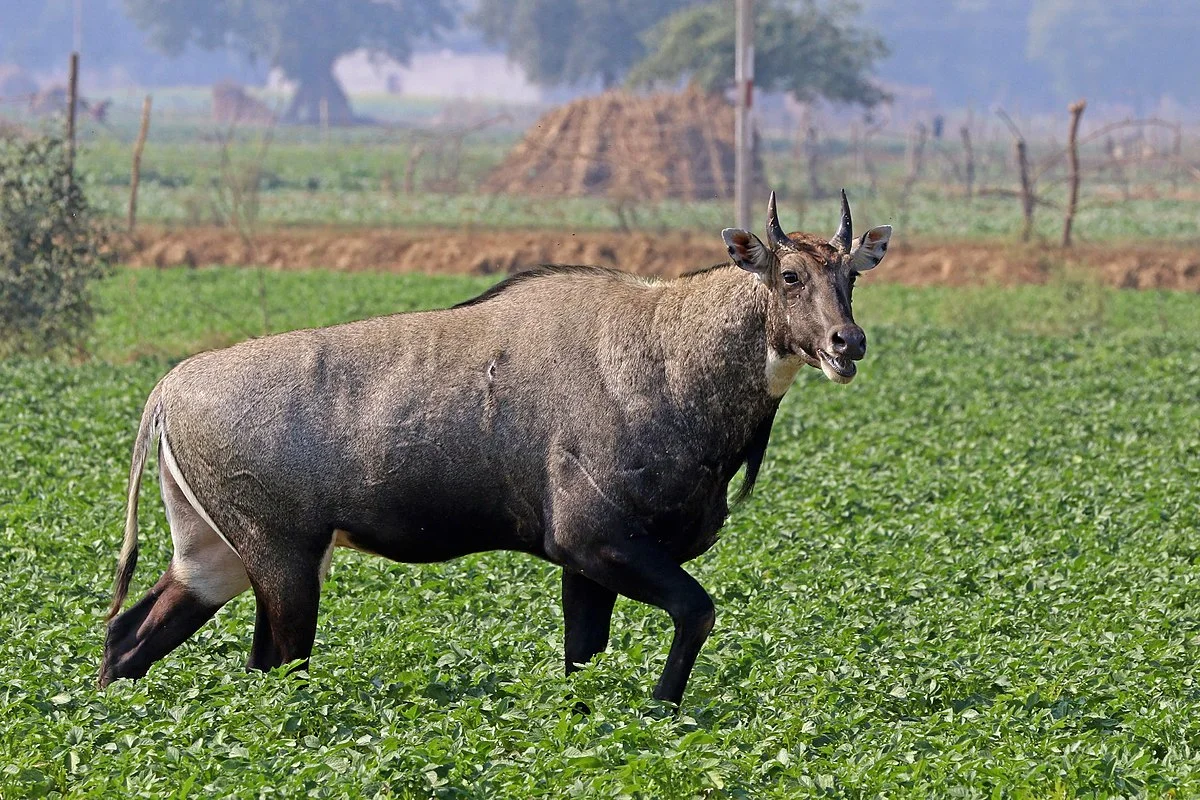 The Nilgai, scientifically known as Boselaphus tragocamelus, stands as a distinctive Indian species of wild cattle, colloquially referred to as the Blue Bull. This sizable antelope, nearly as tall as a human, holds significance in India, where its population, at times, poses a challenge as an agricultural pest. Despite its imposing stature, the Nilgai, meaning “blue cow” in Hindi (nil=blue, gai=cow) Notably, only the males develop horns, which, despite their imposing presence, are relatively modest in size.
The Nilgai, scientifically known as Boselaphus tragocamelus, stands as a distinctive Indian species of wild cattle, colloquially referred to as the Blue Bull. This sizable antelope, nearly as tall as a human, holds significance in India, where its population, at times, poses a challenge as an agricultural pest. Despite its imposing stature, the Nilgai, meaning “blue cow” in Hindi (nil=blue, gai=cow) Notably, only the males develop horns, which, despite their imposing presence, are relatively modest in size.
The Nilgai’s coexistence with the Asiatic Lions in India and its adaptability to diverse ecosystems underscore its ecological importance and resilience in the face of human-wildlife interactions.
Fun Fact – The Nilgai, often called the “Blue Bull,” is the largest Asian antelope. Despite its name, it’s not a true bull but a remarkable member of the antelope family.
21. Nene
| Kingdom | Scientific Name | Life Expectancy | Location |
| Animalia | Branta sandvicensis | Up to 25 years | Hawaii |
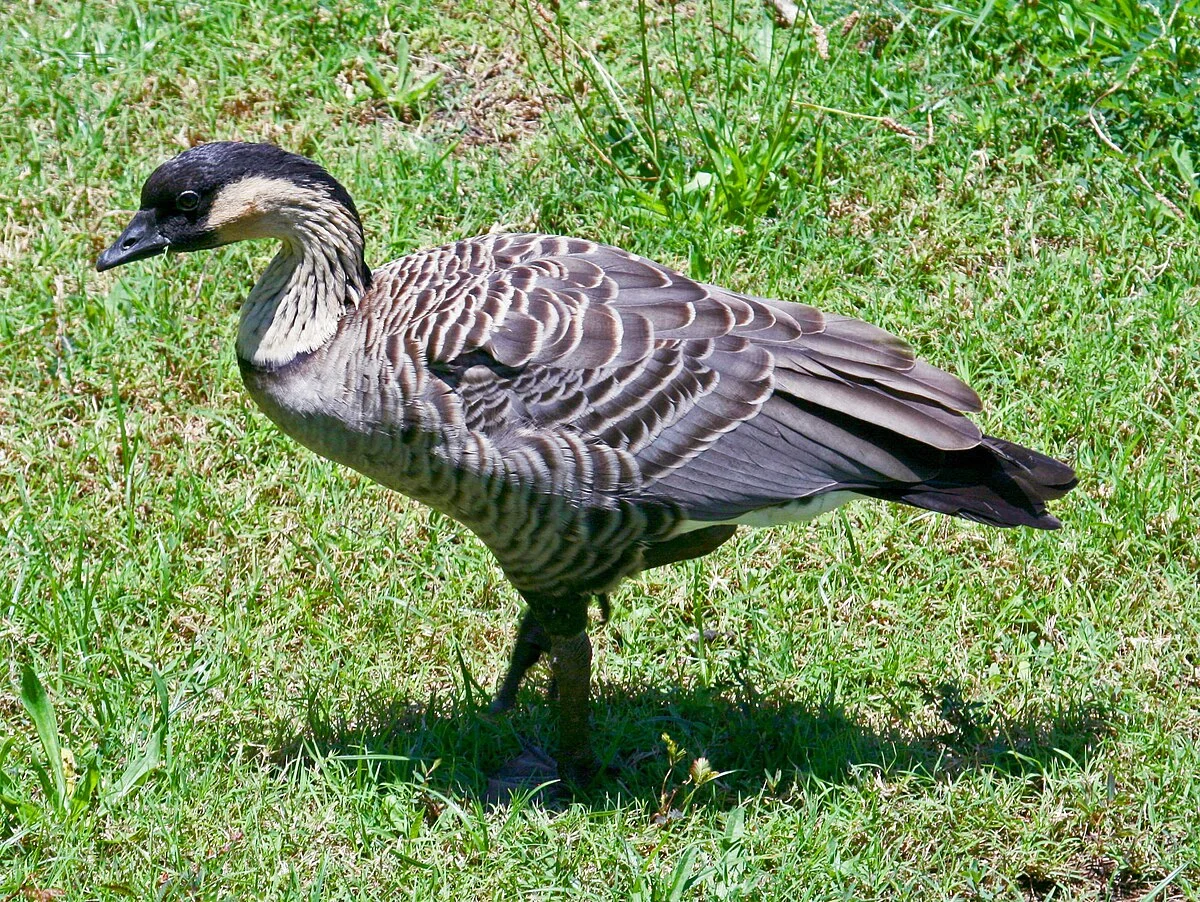 The Nēnē, also known as the Hawaiian Goose (Branta sandvicensis), is a fascinating waterfowl species that holds the title of the world’s rarest goose. Endemic to the Hawaiian Islands, the Nēnē faced near-extinction by 1950 due to habitat loss and predation by non-native species. However, intensive conservation efforts have been underway for decades, leading to a gradual increase in their population.
The Nēnē, also known as the Hawaiian Goose (Branta sandvicensis), is a fascinating waterfowl species that holds the title of the world’s rarest goose. Endemic to the Hawaiian Islands, the Nēnē faced near-extinction by 1950 due to habitat loss and predation by non-native species. However, intensive conservation efforts have been underway for decades, leading to a gradual increase in their population.
Distinctive features of the Nēnē include its small size, brownish plumage, and a black face mask. Despite being a goose, it has adapted to the Hawaiian environment, where it primarily grazes on grasses. The Nēnē’s conservation success serves as a testament to the impact of dedicated efforts in preserving endangered species and restoring their habitats.
Fun Fact – Here’s a fun fact about the Nēnē: these geese have a distinctive ‘nay-nay’ call, which is how they got their name. It’s like they’re adding their own musical touch to the lush Hawaiian landscapes!
22. Neddicky
| Kingdom | Scientific Name | Life Expectancy | Location |
| Animalia | Cisticola fulvicapillus | Up to 8 years | Sub-Saharan Africa |
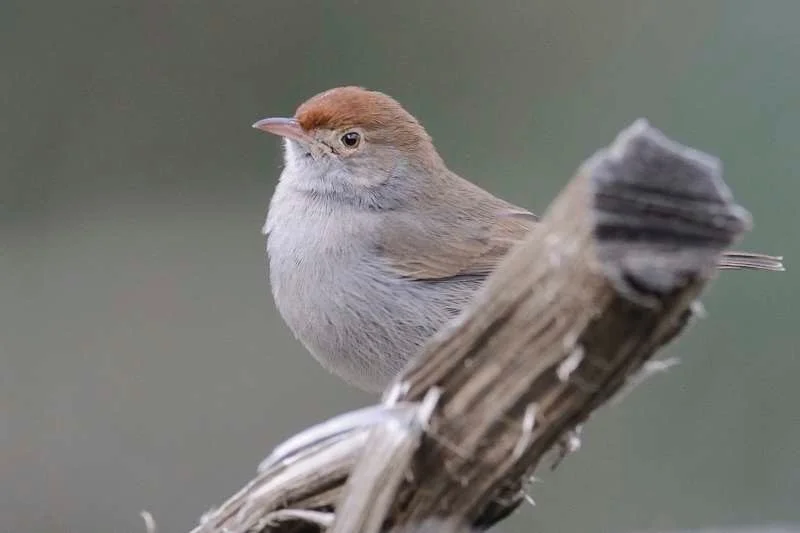 The Neddicky, scientifically known as Cisticola fulvicapilla, is a robin-sized songbird native to Central and Southern Africa. Despite its drab coloring, this bird sports a distinctive rusty red cap, adding a touch of vibrancy to its appearance. The Neddicky is a skilled insect hunter, with a diverse diet that includes termites, moths, caterpillars, and grasshoppers. Its foraging technique involves agile hops, enabling it to pursue flying or jumping insects in the undergrowth. Additionally, this resourceful bird meticulously inspects flowers and leaves, showcasing adaptability in its quest for prey. The Neddicky’s nesting behavior makes it particularly fascinating.
The Neddicky, scientifically known as Cisticola fulvicapilla, is a robin-sized songbird native to Central and Southern Africa. Despite its drab coloring, this bird sports a distinctive rusty red cap, adding a touch of vibrancy to its appearance. The Neddicky is a skilled insect hunter, with a diverse diet that includes termites, moths, caterpillars, and grasshoppers. Its foraging technique involves agile hops, enabling it to pursue flying or jumping insects in the undergrowth. Additionally, this resourceful bird meticulously inspects flowers and leaves, showcasing adaptability in its quest for prey. The Neddicky’s nesting behavior makes it particularly fascinating.
Constructing intricate ball-shaped nests from spiderwebs and dry grasses, it exhibits remarkable architectural skills. The nests, resembling miniature hobbit holes, showcase the bird’s resourcefulness in creating a cozy and secure home. Despite its unassuming appearance, the Neddicky’s unique nesting habits and melodious songs contribute to the rich biodiversity of the African avian landscape.
Fun Fact – The Neddicky is known for its remarkable ability to mimic the calls of various bird species, adding a touch of versatility to its communication repertoire.
23. Numbray
| Kingdom | Scientific Name | Life Expectancy | Location |
| Animalia | Narke dipterygia | Up to 6 years | Australia |
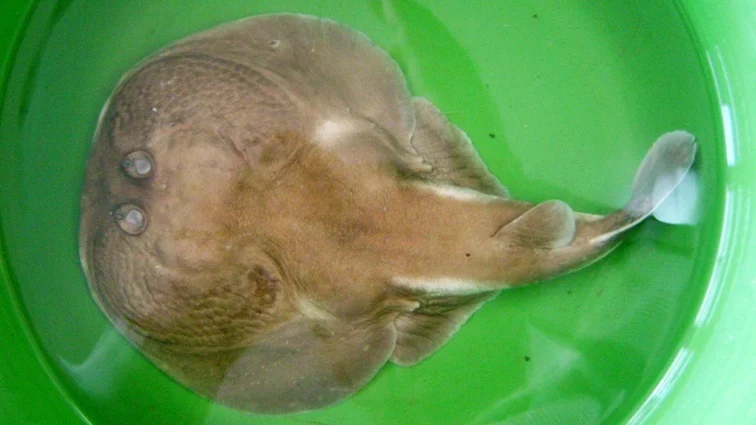 Meet the Numbray, a fascinating ray species native to Australia. Also known as the Spottail Sleeper Ray, it boasts a distinctive feature—it can emit a powerful electric shock, making encounters with it quite shocking! This ray’s habitat includes the sandy coastal areas of Australia, where it strategically hides in the sand, ready to ambush its prey. With a large expandable mouth, the Numbray can swallow its victims whole after immobilizing them with an electric jolt.
Meet the Numbray, a fascinating ray species native to Australia. Also known as the Spottail Sleeper Ray, it boasts a distinctive feature—it can emit a powerful electric shock, making encounters with it quite shocking! This ray’s habitat includes the sandy coastal areas of Australia, where it strategically hides in the sand, ready to ambush its prey. With a large expandable mouth, the Numbray can swallow its victims whole after immobilizing them with an electric jolt.
Fun Fact – The Numbray, also known as the Spottail Sleeper Ray, possesses an expandable mouth and a fascinating method of ambushing its prey. Hiding in the sand, it wraps around its target, delivers an electric shock, and then swallows it whole.
24. Numbat
| Kingdom | Scientific Name | Life Expectancy | Location | |
| Animalia | Chordata | Myrmecobius fasciatus | Up to 5 years | Western Australia |
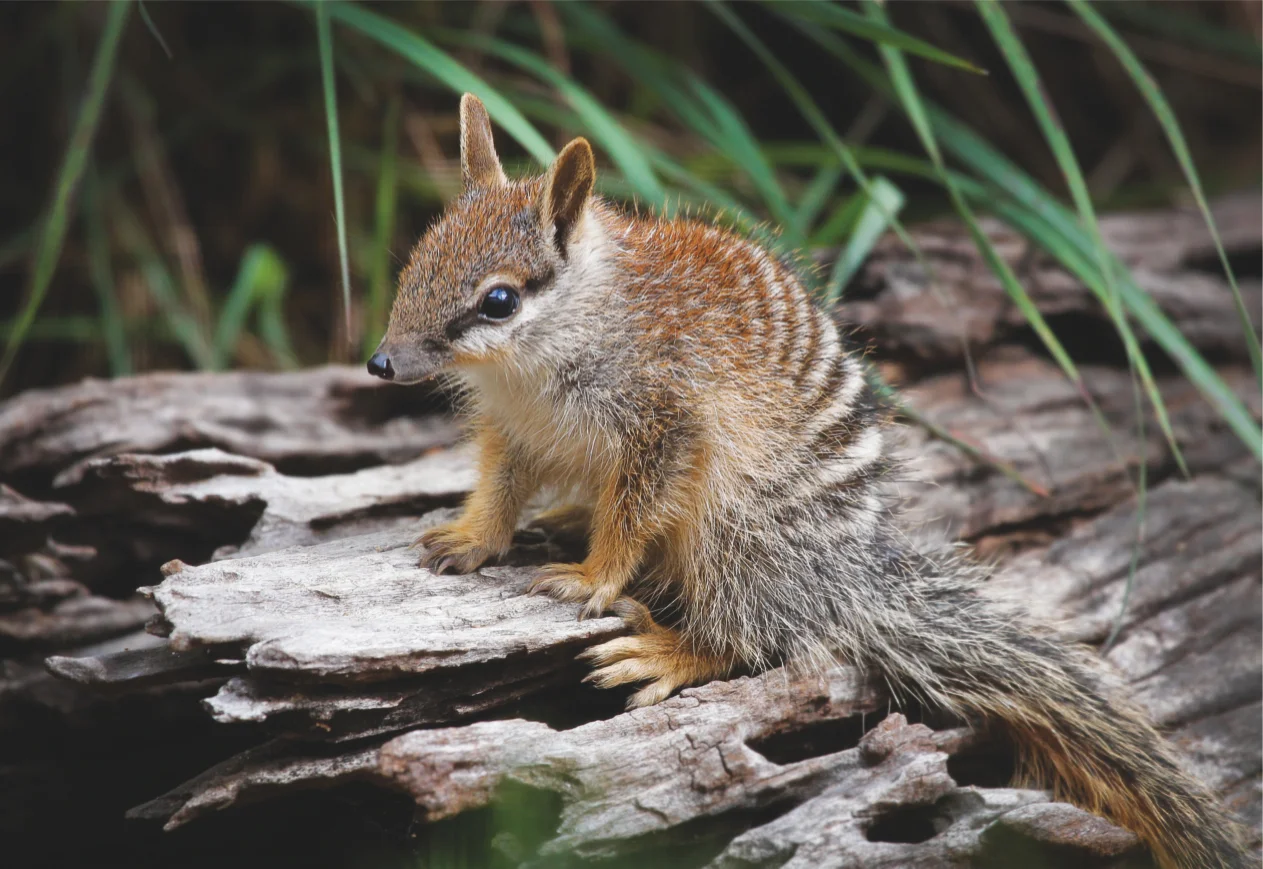 The numbat, scientifically known as Myrmecobius fasciatus, is an extraordinary Australian marsupial celebrated for its distinctive appearance and ecological niche. Referred to as the marsupial anteater, it showcases a slender body adorned with striking banding, making it instantly recognizable. Primarily feasting on termites, the numbat employs a remarkable tongue, resembling that of true anteaters, to extract its insect prey. Unfortunately, this captivating creature is confronting endangerment, with less than a thousand mature individuals remaining in the wild, marking it as a species in need of conservation efforts.
The numbat, scientifically known as Myrmecobius fasciatus, is an extraordinary Australian marsupial celebrated for its distinctive appearance and ecological niche. Referred to as the marsupial anteater, it showcases a slender body adorned with striking banding, making it instantly recognizable. Primarily feasting on termites, the numbat employs a remarkable tongue, resembling that of true anteaters, to extract its insect prey. Unfortunately, this captivating creature is confronting endangerment, with less than a thousand mature individuals remaining in the wild, marking it as a species in need of conservation efforts.
Fun Fact – Despite its nickname “marsupial anteater,” the numbat doesn’t use its long tongue to slurp up ants like its true anteater counterparts. Instead, it employs its tongue to swiftly lick up termites, showcasing a specialized adaptation for its exclusive termite-centric diet.
25. Nutria
| Kingdom | Scientific Name | Life Expectancy | Location |
| Animalia | Myocastor coypus | Up to 8 years | South America, North America, Europe, Asia, Africa |
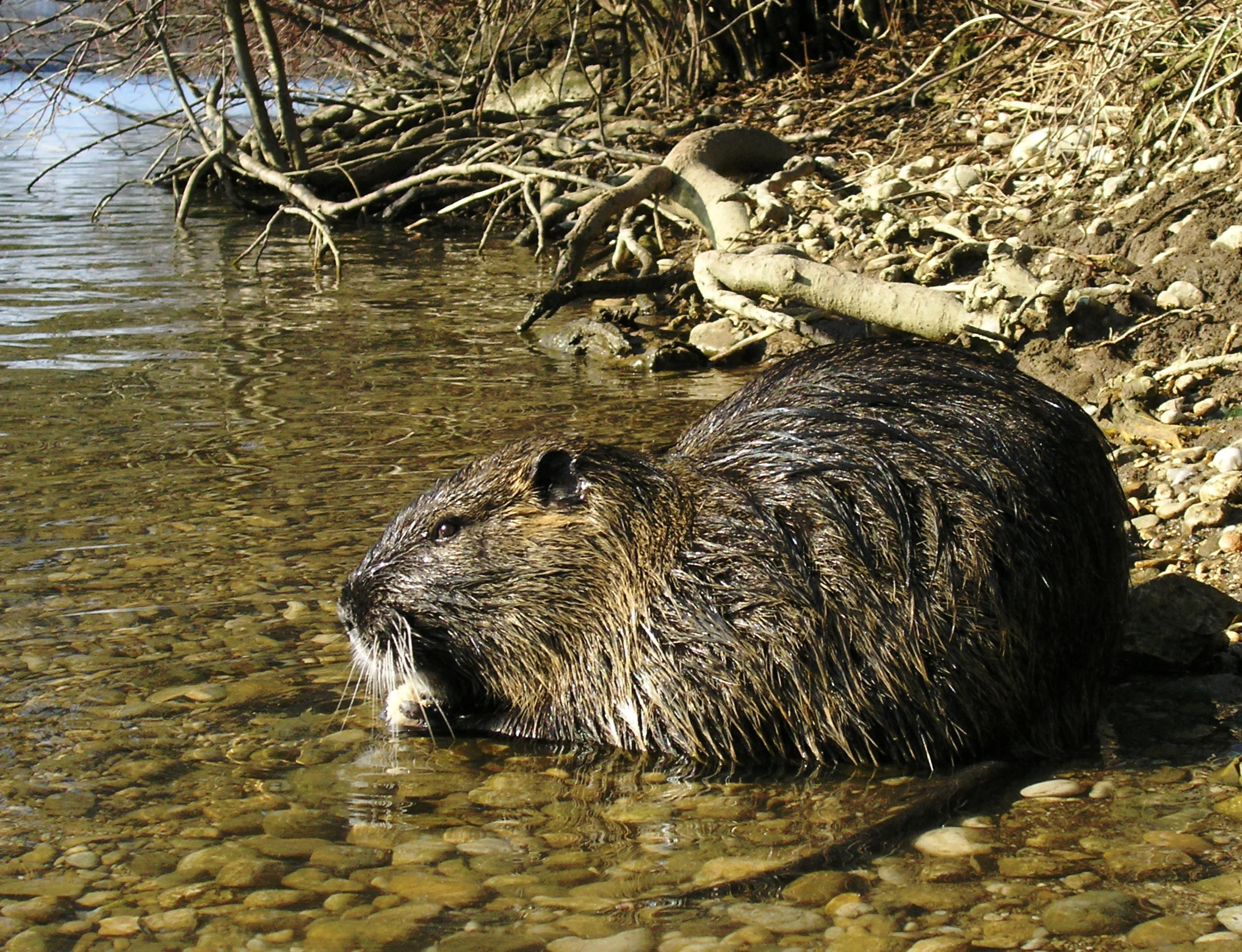 The nutria, also known as the coypu, is a sizable aquatic rodent originating from South America. Initially brought to the United States for fur farming, a small group of around 20 nutrias made a great escape in Louisiana during the late 1930s. What followed was quite unexpected—within just two decades, their population skyrocketed to approximately 20 million. However, this surge in numbers came at a cost. The nutria, with its insatiable appetite for succulent roots, turned from a fur commodity to an invasive species, causing significant damage to numerous acres of wetlands.
The nutria, also known as the coypu, is a sizable aquatic rodent originating from South America. Initially brought to the United States for fur farming, a small group of around 20 nutrias made a great escape in Louisiana during the late 1930s. What followed was quite unexpected—within just two decades, their population skyrocketed to approximately 20 million. However, this surge in numbers came at a cost. The nutria, with its insatiable appetite for succulent roots, turned from a fur commodity to an invasive species, causing significant damage to numerous acres of wetlands.
Fun Fact – Nutrias are prolific eaters, consuming large amounts of vegetation daily. They are known for their distinctive orange teeth that never stop growing, a feature shared with other rodents. Constant gnawing on plant material helps keep their teeth in check.
26. Numbfish
| Kingdom | Scientific Name | Life Expectancy | Location |
| Animalia | Narcinidae | Up to 10 years | Australia |
 The Numbfish, or Tasmanian Numbfish (Narcinidae), is like the superhero of the sea with its special electric powers. Living in the waters around Tasmania, this cool creature has not one, but two electric organs on its head. When it feels threatened, it zaps predators with a moderate electric shock – talk about a shocking defense mechanism!
The Numbfish, or Tasmanian Numbfish (Narcinidae), is like the superhero of the sea with its special electric powers. Living in the waters around Tasmania, this cool creature has not one, but two electric organs on its head. When it feels threatened, it zaps predators with a moderate electric shock – talk about a shocking defense mechanism!
The Numbfish is a crafty hunter, ambushing its prey, delivering a quick shock, and then slurping it up with its stretchy mouth. Imagine having up to 94 tentacles to capture your favorite snacks! This underwater wonder prefers the warm tropical waters, adding a touch of electric excitement to Australia’s marine neighborhoods.
Fun Fact – Numbfish, dwelling in warm tropical waters, form social groups known as “shivers.” In these gatherings, they communicate through subtle electrical signals, creating an underwater electric party of sorts.
27. Nurse Shark
| Kingdom | Scientific Name | Life Expectancy | Location |
| Animalia | Ginglymostoma cirratum | Up to 25 years | Tropical and subtropical waters worldwide |
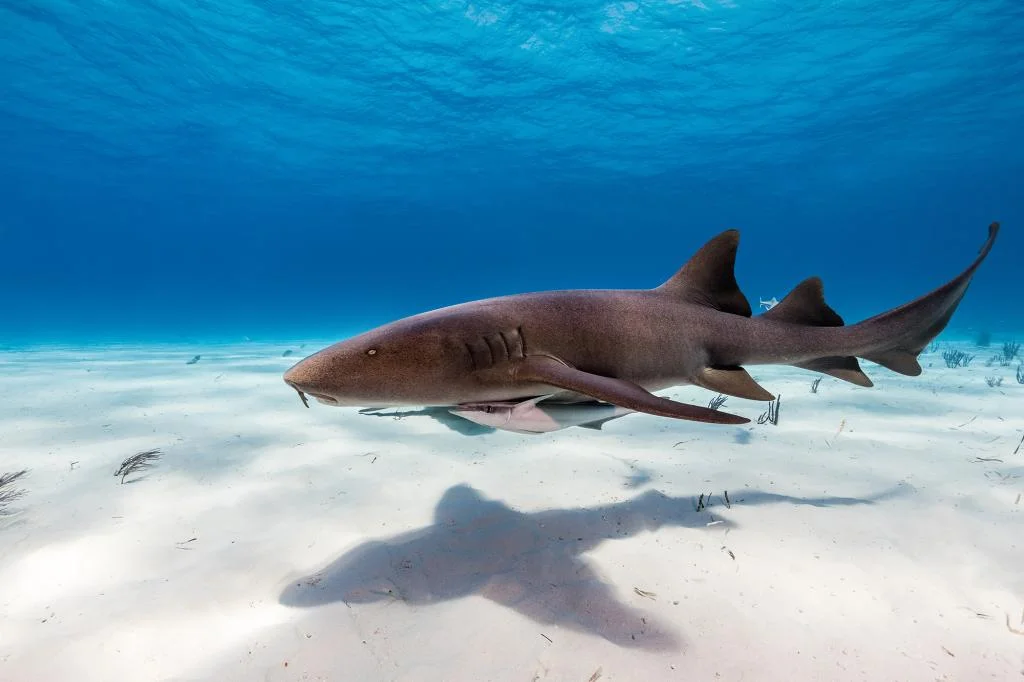 The Nurse Shark (Ginglymostoma cirratum) is like the gentle giant of the ocean, gracefully navigating the tropical and subtropical waters. Its distinctive appearance, marked by whisker-like barbels and a sleek body, sets it apart. Unlike its name might suggest, the nurse shark doesn’t nurse its offspring like mammals but rather lays eggs in underwater nooks.
The Nurse Shark (Ginglymostoma cirratum) is like the gentle giant of the ocean, gracefully navigating the tropical and subtropical waters. Its distinctive appearance, marked by whisker-like barbels and a sleek body, sets it apart. Unlike its name might suggest, the nurse shark doesn’t nurse its offspring like mammals but rather lays eggs in underwater nooks.
Found in coral reefs and shallow waters, these sharks are more of night owls, with their nocturnal habits. Their diet includes a variety of seafood delicacies like crustaceans, small fish, and mollusks, and they’re equipped with robust jaws for efficient prey-crushing. Despite their formidable appearance, nurse sharks are generally calm, often spotted resting on the ocean floor during daylight hours, offering a fascinating sight for divers exploring their underwater realms.
Fun Fact – Despite their docile nature, nurse sharks are known to create a suction force to draw prey into their mouths by inhaling rapidly.
28. Northern Right Whale
| Kingdom | Scientific Name | Life Expectancy | Location |
| Animalia | Eubalaena glacialis | Up to 70 years | North Atlantic Ocean, North Pacific Ocean |
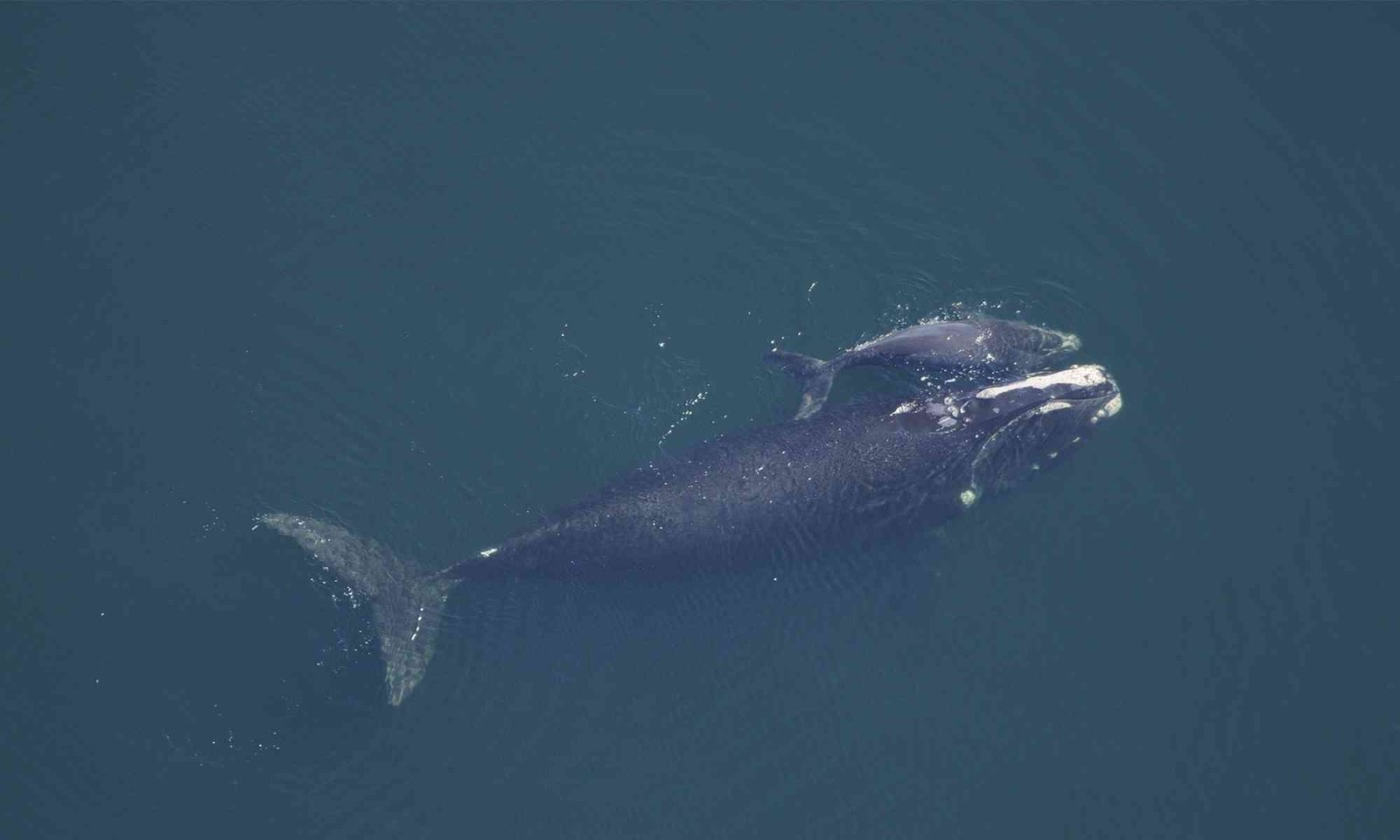 The Northern Right Whale, scientifically labeled Eubalaena glacialis, tugs at the heart as one of the most endangered giants of the ocean. These magnificent beings, known for their immense size and distinctive appearance without a dorsal fin, have faced the harsh brunt of whaling history, teetering on the edge of extinction.
The Northern Right Whale, scientifically labeled Eubalaena glacialis, tugs at the heart as one of the most endangered giants of the ocean. These magnificent beings, known for their immense size and distinctive appearance without a dorsal fin, have faced the harsh brunt of whaling history, teetering on the edge of extinction.
Tragically exploited by hunters, their numbers dwindled to a critical low, and despite ongoing conservation endeavors, only a sparse few hundred individuals remain. Navigating the vast waters of the North Atlantic, these whales embark on extensive journeys for both feeding and calving. Presently, dedicated conservation initiatives strive to shield their habitats and confront myriad challenges, kindling a hopeful beacon for the resurgence of these majestic creatures of the sea.
Fun Fact – Did you know that Northern Right Whales, despite their massive size, are surprisingly agile? They showcase acrobatic displays, leaping out of the water and even slapping their tails in a behavior called “breaching.”
29. Noolbenger
| Kingdom | Scientific Name | Life Expectancy | Location |
| Animalia | Tarsipes rostratus | Up to 6 years | Australia |
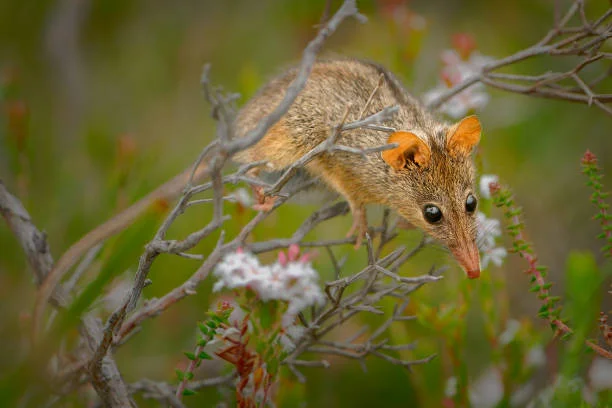 Noolbenger, also known as the Honey Possum, is a captivating marsupial indigenous to the far reaches of southwest Australia. Weighing in at a mere 10 grams, this tiny marvel defies expectations, surviving exclusively on flower nectar and pollen. Picture this: a mouse-sized dynamo with a lengthy, bristly tongue moving at hummingbird speed, sipping up to 7 ml of nectar daily. Its tarsier-like feet, prehensile tail, and pointy nose make it stand out among marsupials. Beyond its diminutive size, the Noolbenger plays a crucial role as a pollinator, contributing to the rich biodiversity of the region.
Noolbenger, also known as the Honey Possum, is a captivating marsupial indigenous to the far reaches of southwest Australia. Weighing in at a mere 10 grams, this tiny marvel defies expectations, surviving exclusively on flower nectar and pollen. Picture this: a mouse-sized dynamo with a lengthy, bristly tongue moving at hummingbird speed, sipping up to 7 ml of nectar daily. Its tarsier-like feet, prehensile tail, and pointy nose make it stand out among marsupials. Beyond its diminutive size, the Noolbenger plays a crucial role as a pollinator, contributing to the rich biodiversity of the region.
Fun Fact – Despite its small stature, the Noolbenger can drink an amount of nectar equivalent to a human consuming 50 liters of soda per day!
30. Nutcracker
| Kingdom | Scientific Name | Life Expectancy | Location |
| Animalia | Nucifraga caryocatactes | Up to 15 years | Northern Hemisphere |
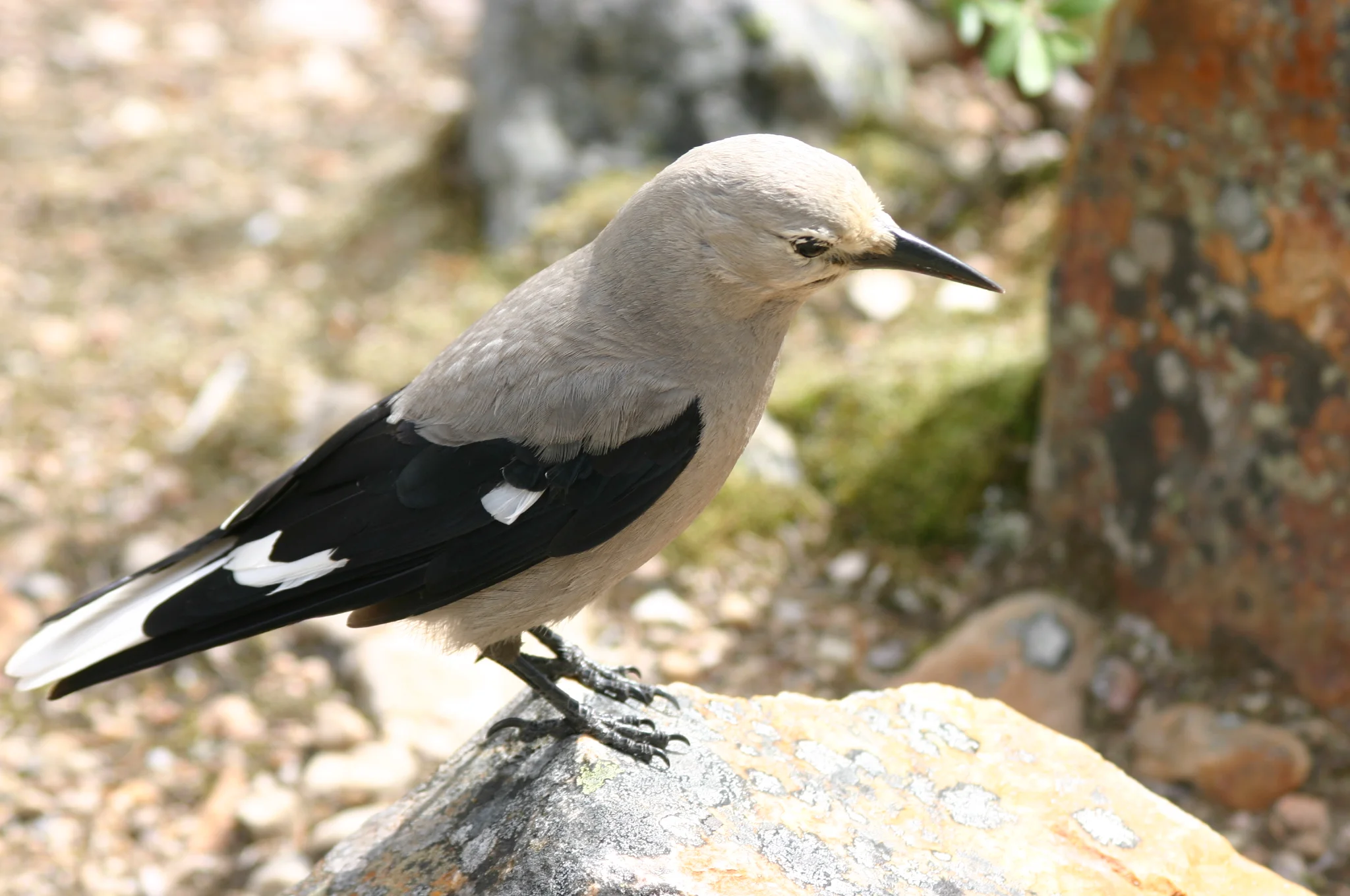 Meet the Nutcracker, a charming avian resident of the lofty Rocky Mountains in the US and Canada. Specifically, Clark’s Nutcracker steals the spotlight with its endearing habits. Armed with a sturdy beak, these birds expertly crack open pine cones to extract seeds. What makes them truly remarkable is their remarkable memory—they diligently store away thousands of these seeds, unintentionally assisting in the reforestation of pine forests.
Meet the Nutcracker, a charming avian resident of the lofty Rocky Mountains in the US and Canada. Specifically, Clark’s Nutcracker steals the spotlight with its endearing habits. Armed with a sturdy beak, these birds expertly crack open pine cones to extract seeds. What makes them truly remarkable is their remarkable memory—they diligently store away thousands of these seeds, unintentionally assisting in the reforestation of pine forests.
The Nutcracker’s unique role as a scatter-hoarder not only showcases their clever foraging tactics but also positions them as unwitting yet essential contributors to the vibrant alpine ecosystems they call home.
Fun Fact – Their remarkable memory allows them to remember the precise locations of thousands of hidden seeds, making them nature’s little foresters.
31. Nicator
| Kingdom | Scientific Name | Life Expectancy | Location |
| Animalia | Nicator chloris | Up to 10 years | Sub-Saharan Africa |
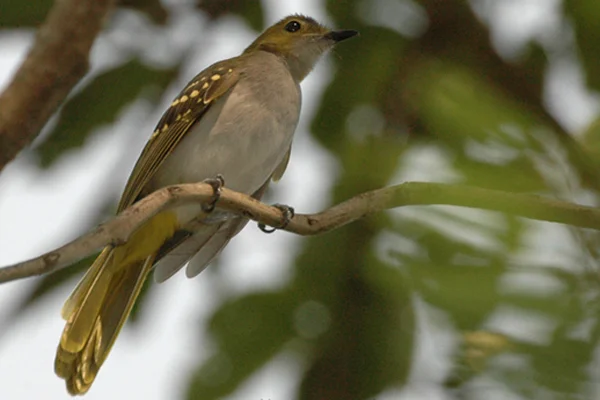 The Nicator, a family of songbirds found in Africa, is home to three unique species: the Western Nicator, Eastern Nicator, and Yellow-throated Nicator. Despite the name, these birds are nothing like evil cartoon robots; instead, they are delightful creatures that bring joy to their surroundings with their captivating songs and colorful feathers. The Western, Eastern, and Yellow-throated Nicators each have their own distinct characteristics, adding to the beauty and diversity of Africa’s birdlife. Their melodies and vibrant plumage make them a cherished part of Africa’s natural symphony, highlighting the marvels of our feathered friends in the wild.
The Nicator, a family of songbirds found in Africa, is home to three unique species: the Western Nicator, Eastern Nicator, and Yellow-throated Nicator. Despite the name, these birds are nothing like evil cartoon robots; instead, they are delightful creatures that bring joy to their surroundings with their captivating songs and colorful feathers. The Western, Eastern, and Yellow-throated Nicators each have their own distinct characteristics, adding to the beauty and diversity of Africa’s birdlife. Their melodies and vibrant plumage make them a cherished part of Africa’s natural symphony, highlighting the marvels of our feathered friends in the wild.
Fun Fact – The Western Nicator, Eastern Nicator, and Yellow-throated Nicator are skilled mimics, often incorporating the sounds of other birds into their songs, showcasing their impressive vocal repertoire in the dense forests of Africa.
32. Nyala
| Kingdom | Scientific Name | Life Expectancy | Location |
| Animalia | Tragelaphus angasii | Up to 19 years | Southern Africa |
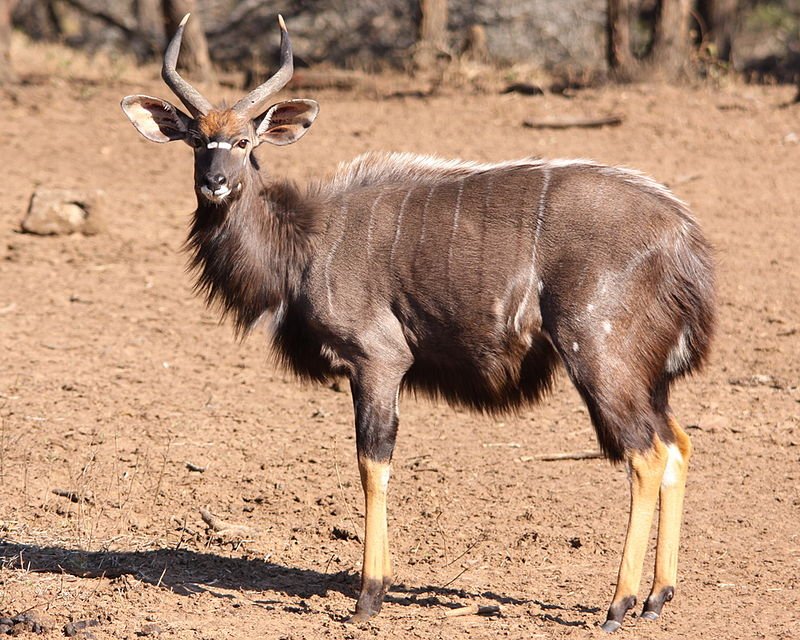 The Nyala (Tragelaphus angasii) is a captivating antelope native to the enchanting landscapes of Southern Africa. What sets the Nyala apart is its fascinating display of sexual dimorphism. Picture this: adult males sport a luxurious dark shaggy brown coat paired with elegant spiral horns, while their counterparts, the females and young males, showcase a vibrant rusty orange hue adorned with whimsical white stripes and dots.
The Nyala (Tragelaphus angasii) is a captivating antelope native to the enchanting landscapes of Southern Africa. What sets the Nyala apart is its fascinating display of sexual dimorphism. Picture this: adult males sport a luxurious dark shaggy brown coat paired with elegant spiral horns, while their counterparts, the females and young males, showcase a vibrant rusty orange hue adorned with whimsical white stripes and dots.
These beautiful creatures prefer to keep to themselves, seeking refuge in the heart of dense vegetation. Spotting a Nyala during a South African safari feels like stumbling upon a hidden gem. Their unique colors and majestic horns add an extra layer of magic to the already enchanting wilderness of Southern Africa.
Fun Fact – Interestingly, Nyalas, while typically shy and preferring dense cover, have been observed showcasing intricate courtship rituals involving head bobbing, tail flicking, and vocalizations.
33. Nunbird
| Kingdom | Scientific Name | Life Expectancy | Location |
| Animalia | Monasa nigrifrons | Up to 10 years | Central and South America |
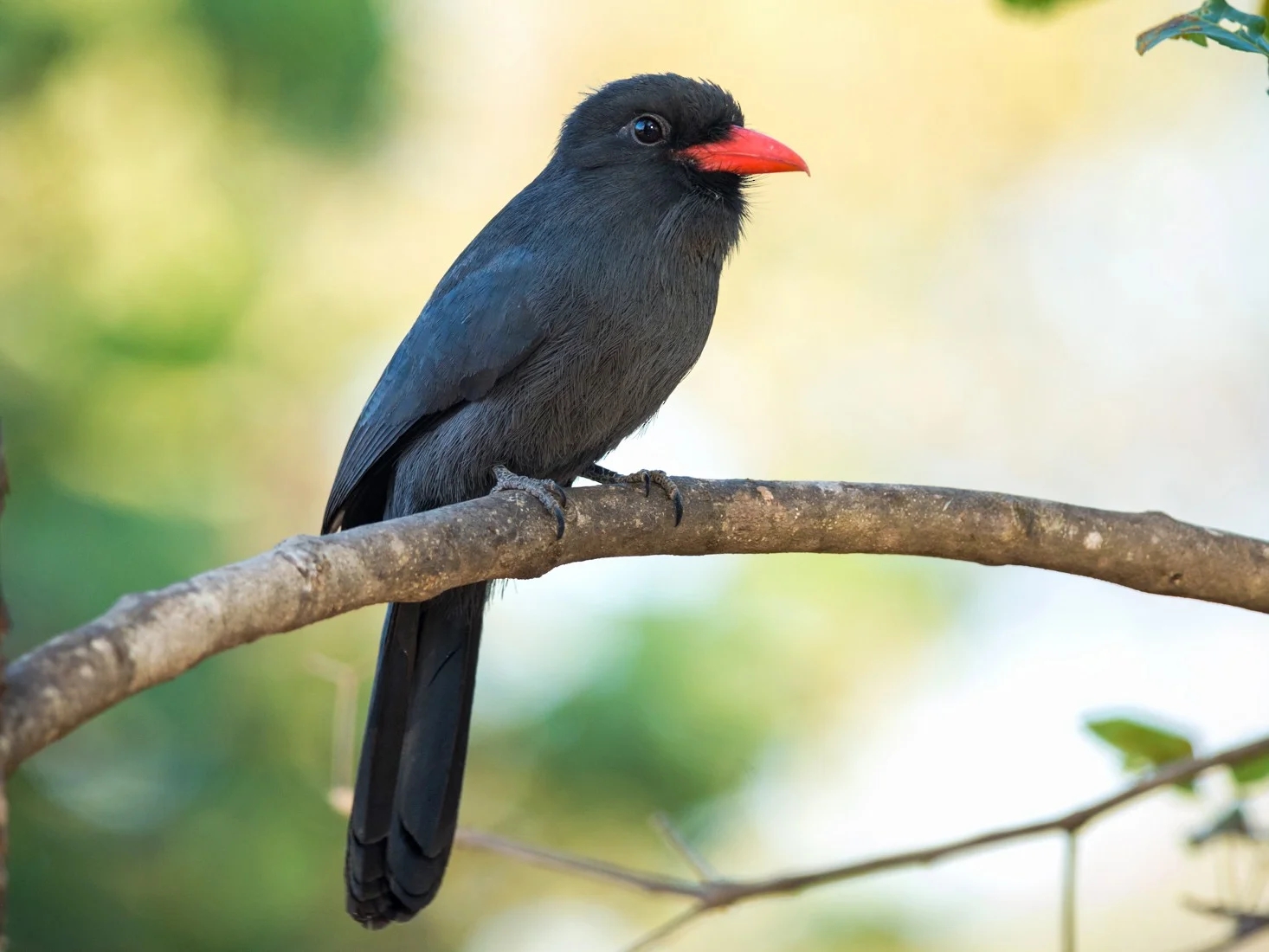 The Nunbird, especially the White-fronted Nunbird showcased in this illustration, is a captivating bird native to the vibrant landscapes of Central and South America. A member of the puffbird family Monasa, these birds sport glossy, dark feathers with a distinctive white patch near their beaks, resembling the attire of a nun. Among the four species in its genus, Nunbirds are renowned for their skillful construction of spherical nests woven from spiderwebs and dry grasses. Despite their modest coloring, Nunbirds exudes a unique charm, and their intricate nests showcase a remarkable aspect of avian ingenuity. Fun Fact – Nunbirds engage in cooperative parenting, with non-breeding members assisting in raising nestlings. This unique social behavior highlights their collaborative approach to ensuring the well-being of offspring.
The Nunbird, especially the White-fronted Nunbird showcased in this illustration, is a captivating bird native to the vibrant landscapes of Central and South America. A member of the puffbird family Monasa, these birds sport glossy, dark feathers with a distinctive white patch near their beaks, resembling the attire of a nun. Among the four species in its genus, Nunbirds are renowned for their skillful construction of spherical nests woven from spiderwebs and dry grasses. Despite their modest coloring, Nunbirds exudes a unique charm, and their intricate nests showcase a remarkable aspect of avian ingenuity. Fun Fact – Nunbirds engage in cooperative parenting, with non-breeding members assisting in raising nestlings. This unique social behavior highlights their collaborative approach to ensuring the well-being of offspring.
34. Namaqua Chameleon
| Kingdom | Scientific Name | Life Expectancy | Location |
| Animalia | Chamaeleo namaquensis | Up to 5 years | Namibia and South Africa |
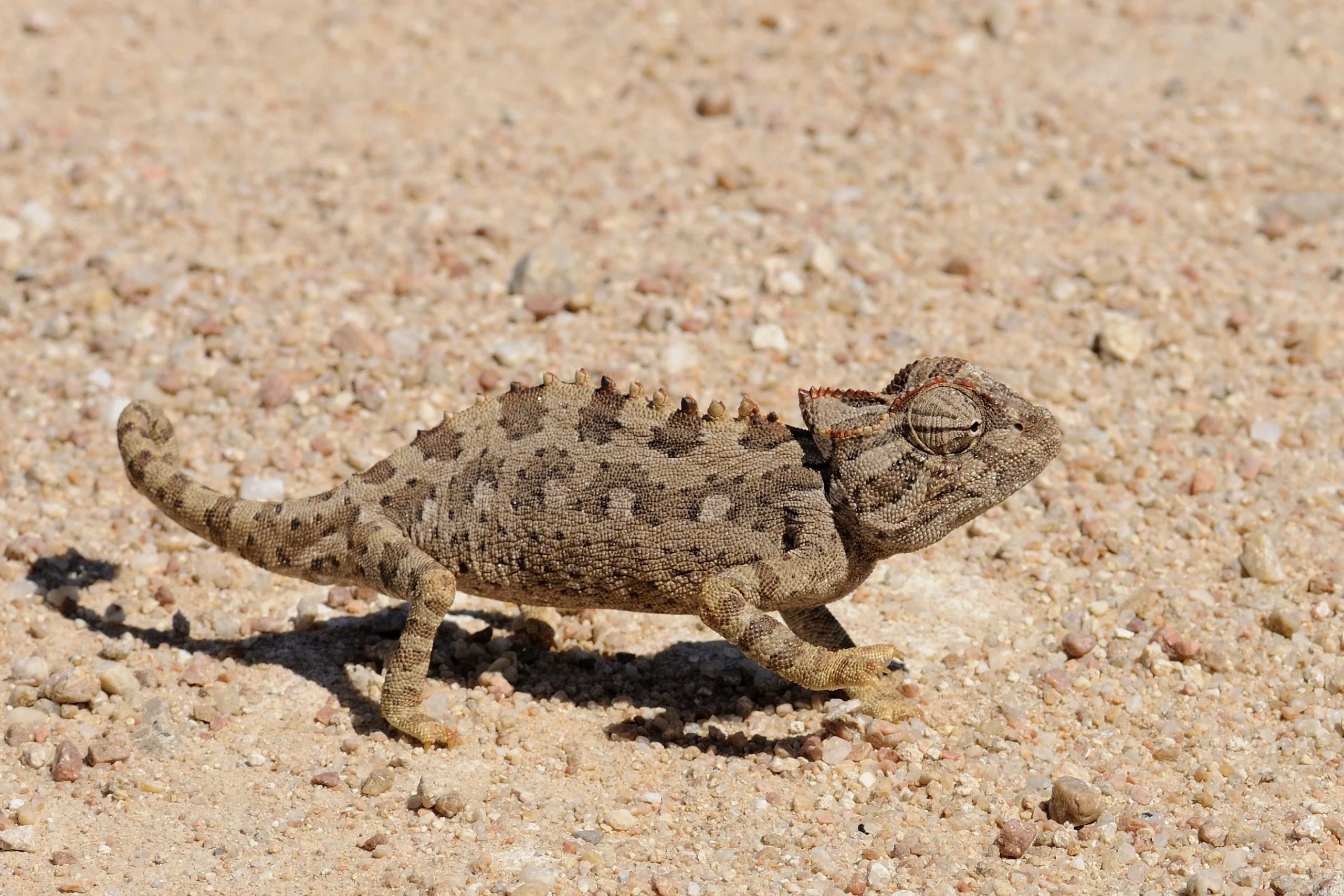 Hailing from the arid landscapes of southwestern Africa, the Namaqua chameleon is a true marvel of adaptation. Its unique features, like the flattened body, expressive eyes, and a tail with a mind of its own, paint a picture of evolutionary brilliance. But what truly steals the show is its color-changing prowess – not just a fashion statement, it’s a survival tactic. Camouflage, emotion display, or temperature control, this chameleon’s skin is a canvas of communication.
Hailing from the arid landscapes of southwestern Africa, the Namaqua chameleon is a true marvel of adaptation. Its unique features, like the flattened body, expressive eyes, and a tail with a mind of its own, paint a picture of evolutionary brilliance. But what truly steals the show is its color-changing prowess – not just a fashion statement, it’s a survival tactic. Camouflage, emotion display, or temperature control, this chameleon’s skin is a canvas of communication.
This little fellow has desert life down to an art. Specially designed feet make it a stroll expert on various terrains. Patient and precise, it spots its insect prey with those sharp eyes. In the challenging world of arid ecosystems, the Namaqua chameleon stands as a pint-sized maestro, showcasing resilience and clever strategies for life in the desert heat.
Fun Fact – The Namaqua chameleon is a desert virtuoso, not just in color-changing expertise but also in hydration survival. It drinks dew, licking moisture off its body in the early morning—a quirky adaptation to the harsh arid environment.
35. Norwegian Forest Cat
| Kingdom | Scientific Name | Life Expectancy | Location |
| Animalia | Felis catus | 12 to 16 years | Norway (origin), Worldwide |
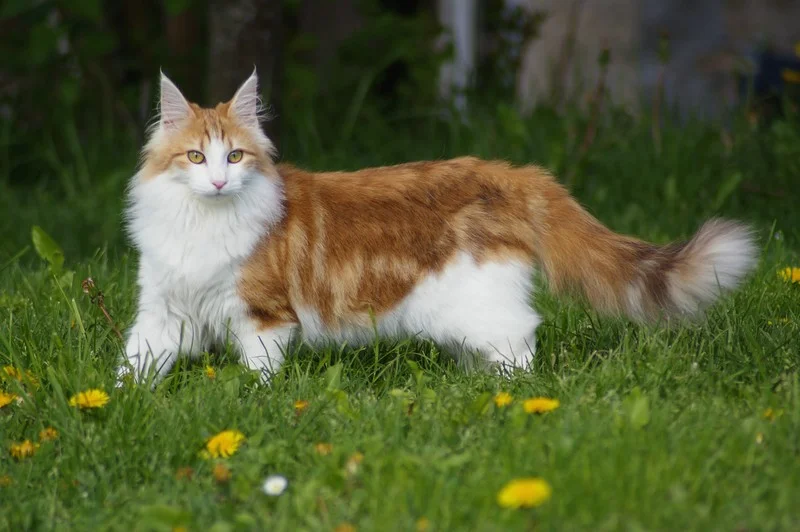 The Norwegian Forest Cat, affectionately known as the “Wegie,” is a captivating feline breed that boasts a rich history intertwined with Norwegian folklore. With its semi-longhaired coat, tufted ears, and bushy tail, this cat exhibits both elegance and adaptability to the harsh Nordic climate. Its tufted paws serve as functional insulation, making it not only visually striking but also well-suited to colder temperatures. Beyond its regal appearance, the Norwegian Forest Cat is a playful and affectionate companion, embodying the spirit of the northern wilderness with every graceful stride.
The Norwegian Forest Cat, affectionately known as the “Wegie,” is a captivating feline breed that boasts a rich history intertwined with Norwegian folklore. With its semi-longhaired coat, tufted ears, and bushy tail, this cat exhibits both elegance and adaptability to the harsh Nordic climate. Its tufted paws serve as functional insulation, making it not only visually striking but also well-suited to colder temperatures. Beyond its regal appearance, the Norwegian Forest Cat is a playful and affectionate companion, embodying the spirit of the northern wilderness with every graceful stride.
Fun Fact – Norwegian Forest Cats are skilled climbers, showcasing agility reminiscent of lynxes.
36. Neapolitan Mastiff
| Kingdom | Scientific Name | Life Expectancy | Location |
| Animalia | Canis lupus familiaris | 7 to 9 years | Italy (origin), Worldwide |
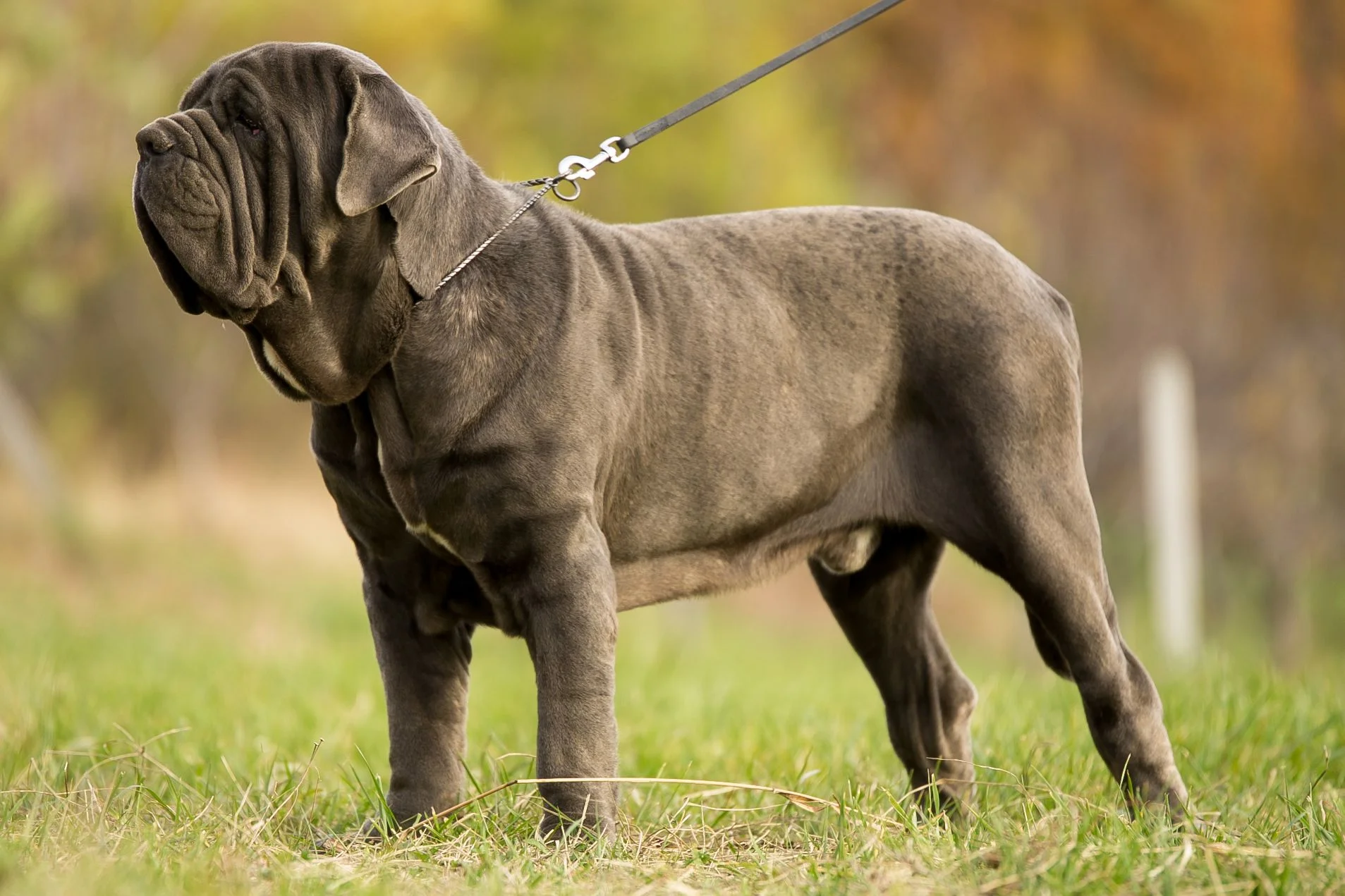 Originating from Italy, the Neapolitan Mastiff is a distinctive and colossal breed with roots tracing back to ancient Rome. Renowned for its loose, wrinkled skin and unique appearance, this breed was initially bred for guarding and protection. Despite its imposing stature, the Neapolitan Mastiff is known for its gentle nature and unwavering loyalty to its human pack. The massive build, accentuated by hanging jowls, contributes to its imposing yet endearing presence, making it both a formidable guardian and a gentle giant within the household.
Originating from Italy, the Neapolitan Mastiff is a distinctive and colossal breed with roots tracing back to ancient Rome. Renowned for its loose, wrinkled skin and unique appearance, this breed was initially bred for guarding and protection. Despite its imposing stature, the Neapolitan Mastiff is known for its gentle nature and unwavering loyalty to its human pack. The massive build, accentuated by hanging jowls, contributes to its imposing yet endearing presence, making it both a formidable guardian and a gentle giant within the household.
Fun Fact – The Neapolitan Mastiff’s “Mastino stare” serves as an intimidating warning, reflecting its protective instincts.
37. Newfoundland
| Kingdom | Scientific Name | Life Expectancy | Location |
| Animalia | Canis lupus | 9 to 10 years | Newfoundland, Canada (origin), Worldwide |
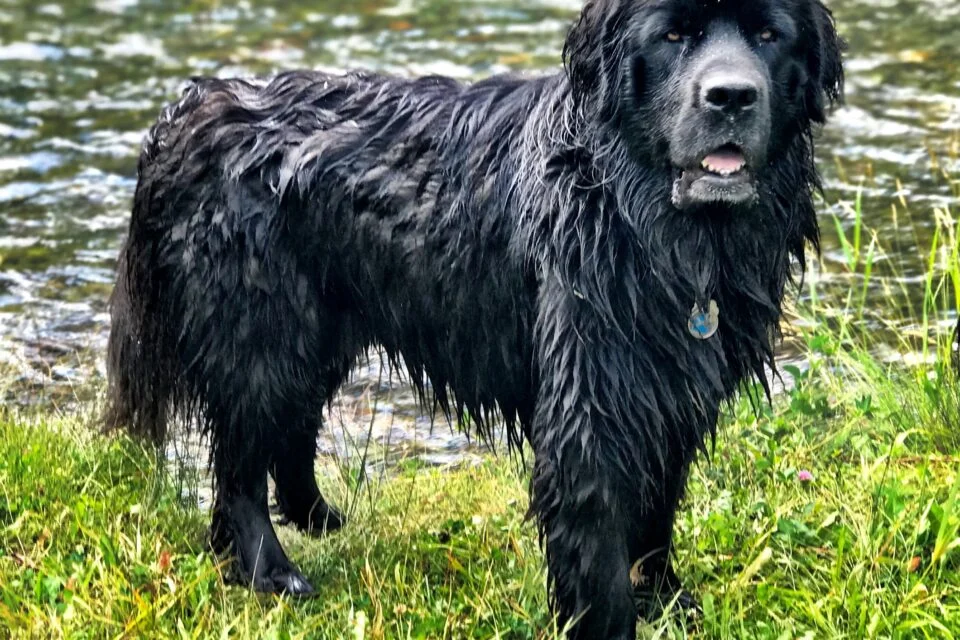 The Newfoundland, affectionately called “Newfie,” is a colossal canine native to the rugged shores of Newfoundland, Canada. Bred for assisting fishermen, these dogs are exceptional swimmers, equipped with webbed feet and a water-resistant double coat. Their strength, coupled with a gentle and patient disposition, has endeared them as ideal family companions. Whether performing water rescues or simply showering affection, Newfoundlands embody a harmonious blend of strength and warmth, securing their place as one of the most beloved working breeds.
The Newfoundland, affectionately called “Newfie,” is a colossal canine native to the rugged shores of Newfoundland, Canada. Bred for assisting fishermen, these dogs are exceptional swimmers, equipped with webbed feet and a water-resistant double coat. Their strength, coupled with a gentle and patient disposition, has endeared them as ideal family companions. Whether performing water rescues or simply showering affection, Newfoundlands embody a harmonious blend of strength and warmth, securing their place as one of the most beloved working breeds.
Fun Fact – Beyond water rescue, Newfoundlands are gentle with children, earning them the nickname “Nature’s Babysitter.”
38. Norfolk Terrier
| Kingdom | Scientific Name | Life Expectancy | Location |
| Animalia | Canis lupus familiaris | 12 to 15 years | United Kingdom (origin), Worldwide |
 The Norfolk Terrier, a small terrier with a big personality, traces its origins to England. Initially bred for vermin hunting, these dogs feature a wiry coat, perky ears, and a compact yet sturdy build. Beyond their hunting prowess, Norfolk Terriers seamlessly transition into cherished family pets. With intelligence, adaptability, and a friendly demeanor, these terriers bring joy and companionship to households, proving that great things indeed come in small packages.
The Norfolk Terrier, a small terrier with a big personality, traces its origins to England. Initially bred for vermin hunting, these dogs feature a wiry coat, perky ears, and a compact yet sturdy build. Beyond their hunting prowess, Norfolk Terriers seamlessly transition into cherished family pets. With intelligence, adaptability, and a friendly demeanor, these terriers bring joy and companionship to households, proving that great things indeed come in small packages.
Fun Fact – Norfolk Terriers, natural rat hunters, exhibit a charming yet persistent digging behavior.
39. North American Black Bear
| Kingdom | Scientific Name | Life Expectancy | Location |
| Animalia | Ursus americanus | 20 to 30 years | North America |
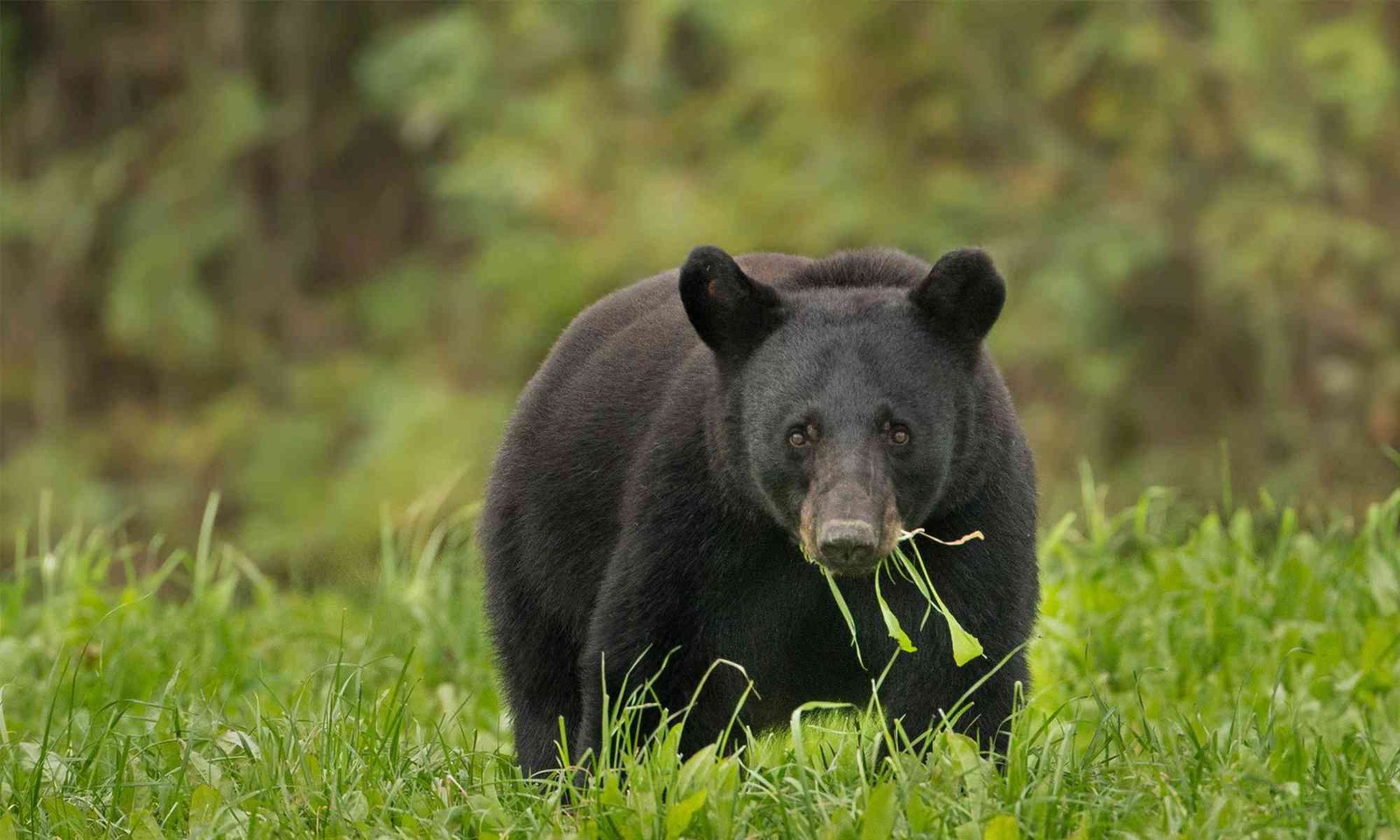 The North American Black Bear, an emblem of the continent’s wild landscapes, is a highly adaptable species displaying a range of colors, from black and brown to cinnamon. Thriving from coast to coast, these bears showcase remarkable intelligence and resourcefulness. Despite their robust build, they often remain elusive, embodying the mystery of the wilderness. The black bear’s significance in North American ecosystems and its ability to thrive in diverse habitats underscore its iconic status in the region’s fauna.
The North American Black Bear, an emblem of the continent’s wild landscapes, is a highly adaptable species displaying a range of colors, from black and brown to cinnamon. Thriving from coast to coast, these bears showcase remarkable intelligence and resourcefulness. Despite their robust build, they often remain elusive, embodying the mystery of the wilderness. The black bear’s significance in North American ecosystems and its ability to thrive in diverse habitats underscore its iconic status in the region’s fauna.
Fun Fact – Despite their size, North American Black Bears are adept tree climbers, adding to their impressive adaptations.
40. Northern Inuit Dog
| Kingdom | Scientific Name | Life Expectancy | Location |
| Animalia | Canis lupus familiaris | 12 to 14 years | United Kingdom |
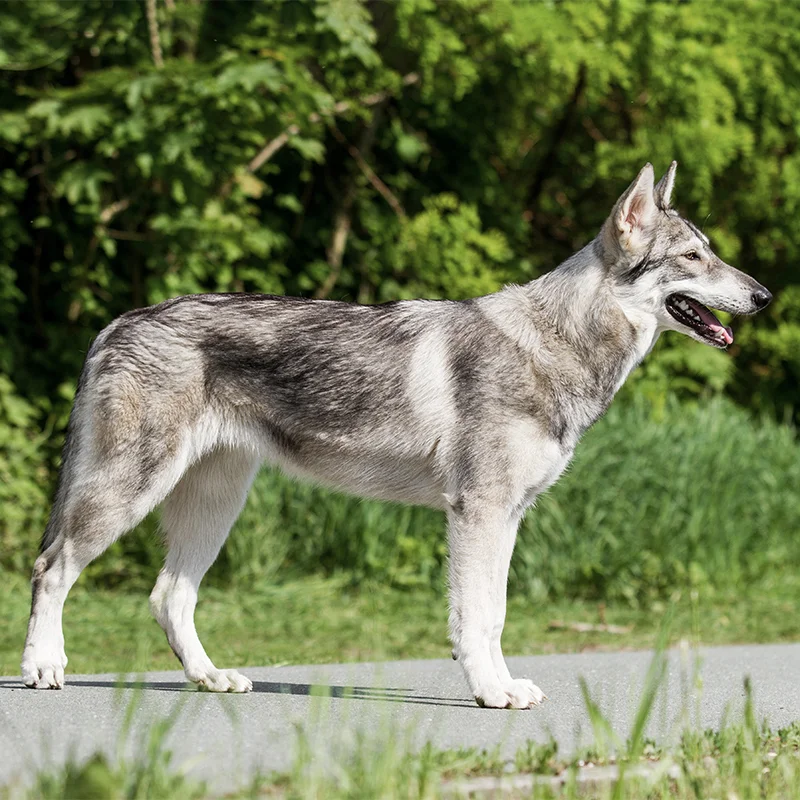 The Northern Inuit Dog, designed to resemble wolves, emerges from a deliberate crossbreeding of German Shepherds, Siberian Huskies, and Inuit dogs. This intentional blend results in a captivating, wolf-like appearance that pays homage to the breed’s wild ancestry. Known for intelligence, loyalty, and friendly nature, Northern Inuit Dogs seamlessly integrate into family life, exuding a majestic yet approachable demeanor. Their striking resemblance to wolves adds an element of mystique, making them not only devoted companions but also a living testament to the enduring connection between humans and their untamed ancestors.
The Northern Inuit Dog, designed to resemble wolves, emerges from a deliberate crossbreeding of German Shepherds, Siberian Huskies, and Inuit dogs. This intentional blend results in a captivating, wolf-like appearance that pays homage to the breed’s wild ancestry. Known for intelligence, loyalty, and friendly nature, Northern Inuit Dogs seamlessly integrate into family life, exuding a majestic yet approachable demeanor. Their striking resemblance to wolves adds an element of mystique, making them not only devoted companions but also a living testament to the enduring connection between humans and their untamed ancestors.
Fun Fact – The Northern Inuit Dog’s vocal range, including howls and barks, reflects its wolf-like ancestry and adds to its captivating nature.
Bottom Line
In summary, our expedition into the realm of creatures starting with “N” has been an eye-opening adventure. From the unique Naked Mole Rat to the majestic Northern Right Whale, these animals showcase the incredible diversity of our planet’s fauna. This journey serves as a reminder of the delicate balance within ecosystems and the need for conservation to protect these remarkable beings and their environments. As stewards of the Earth, it’s our responsibility to champion initiatives that ensure the survival of these species and maintain the rich tapestry of life. Let’s continue to marvel at the wonders of the natural world and actively contribute to the preservation of our planet’s biodiversity.


